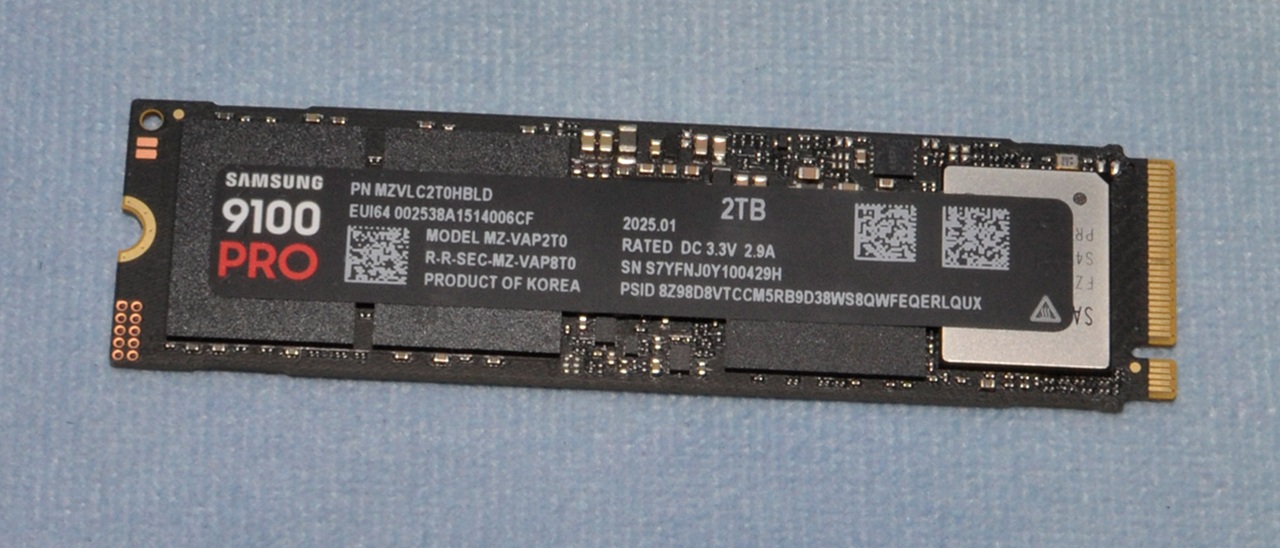Why you can trust Tom's Hardware
Comparison Products
The competition at 4TB looks a bit different, especially as we are able to test the 9100 Pro both with and without a heatsink. Generally drives do not get hot enough for the heatsink to radically improve scores, and the 9100 Pro runs efficiently enough for that to be especially true.
First up is the high-end PCIe 5.0 SSD, the Crucial T700. This drive is very similar to the T705, although a bit slower. We’ve also reviewed later-arriving 4TB SKUs on some drives such as the Crucial T500 and Samsung 990 Pro, the latter of which ended up using newer flash that’s also present on the 9100 Pro. Some popular budget 4TB drives include the Patriot Viper VP4300 Lite, the Addlink A93, and the Lexar Play. Some drives in this category, such as the Viper VP4300 Lite, have swapped to slower QLC flash. As such they are more competitive with the WD Blue SN5000.
Lastly, we have Phison E18-based drives which were among the first high-end PCIe 4.0 SSDs available. These could be compared to the T700 and T705’s E26 for the 5.0 generation. Drives such as the Seagate FireCuda 530, the Sabrent Rocket 4 Plus-G, and the Netac NV7000 remain popular when looking for higher-capacity storage solutions.
Trace Testing — 3DMark Storage Benchmark
Built for gamers, 3DMark’s Storage Benchmark focuses on real-world gaming performance. Each round in this benchmark stresses storage based on gaming activities including loading games, saving progress, installing game files, and recording gameplay video streams. Future gaming benchmarks will be DirectStorage-inclusive and we also include notes about which drives may be future-proofed.
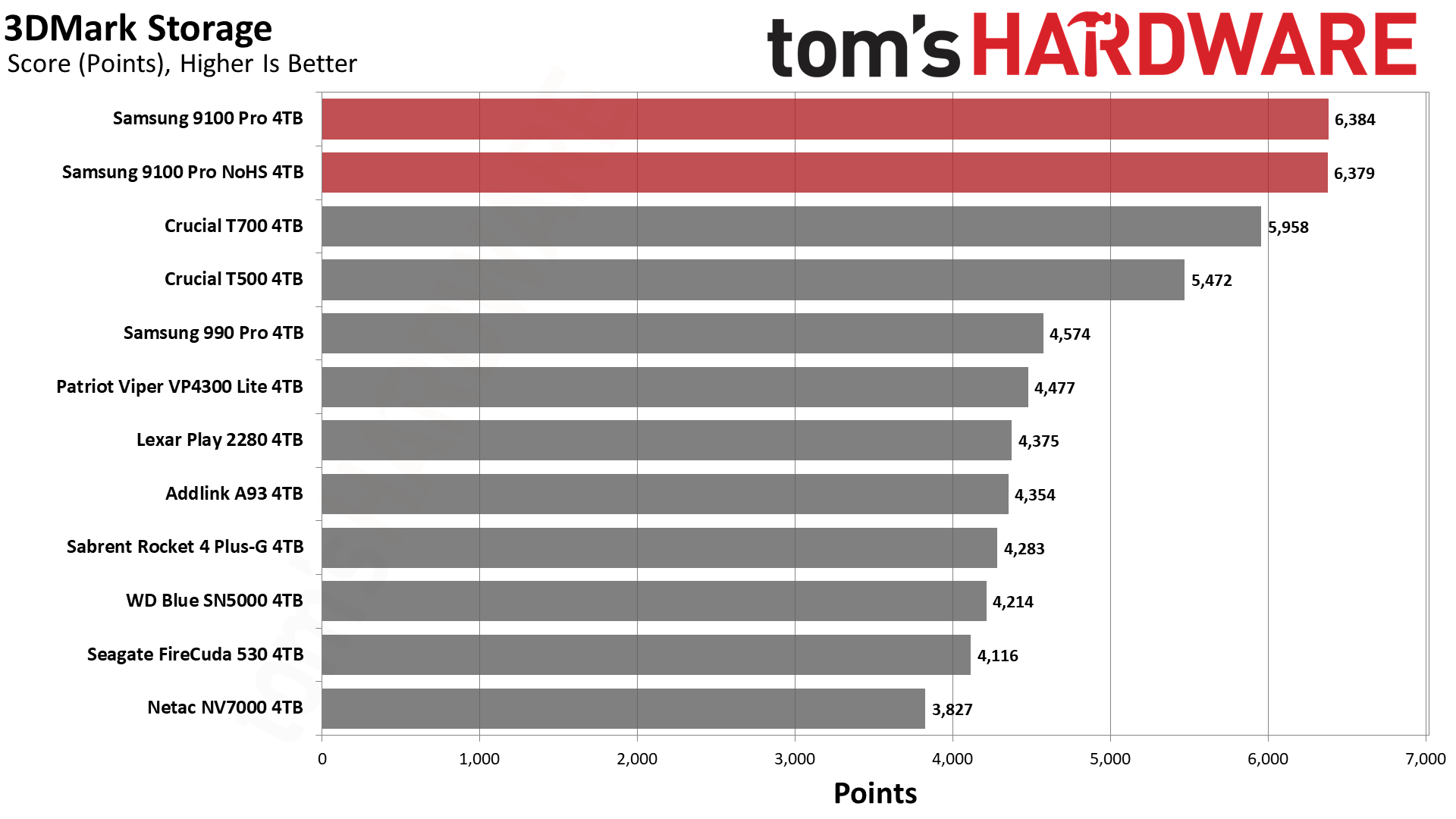
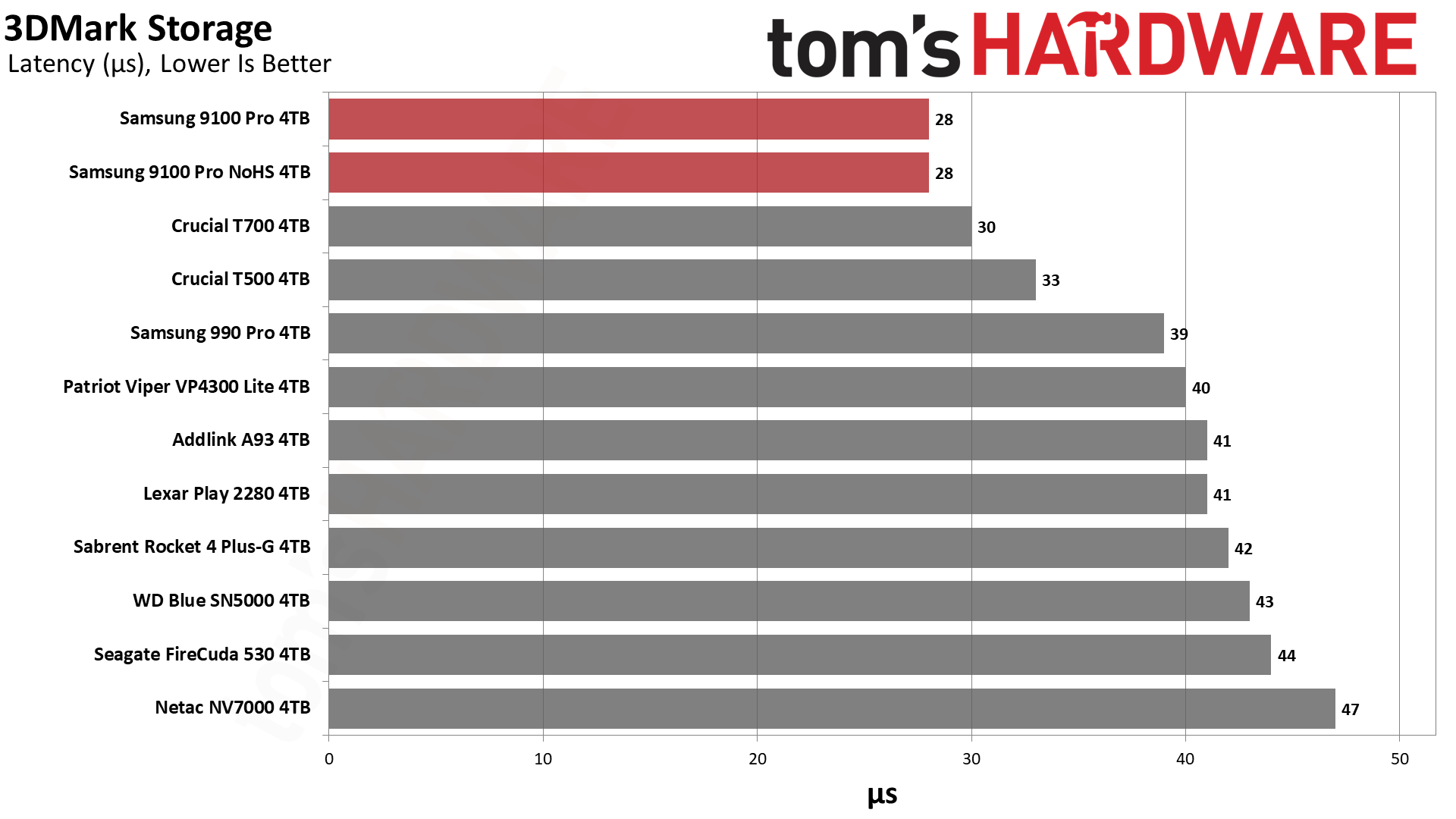
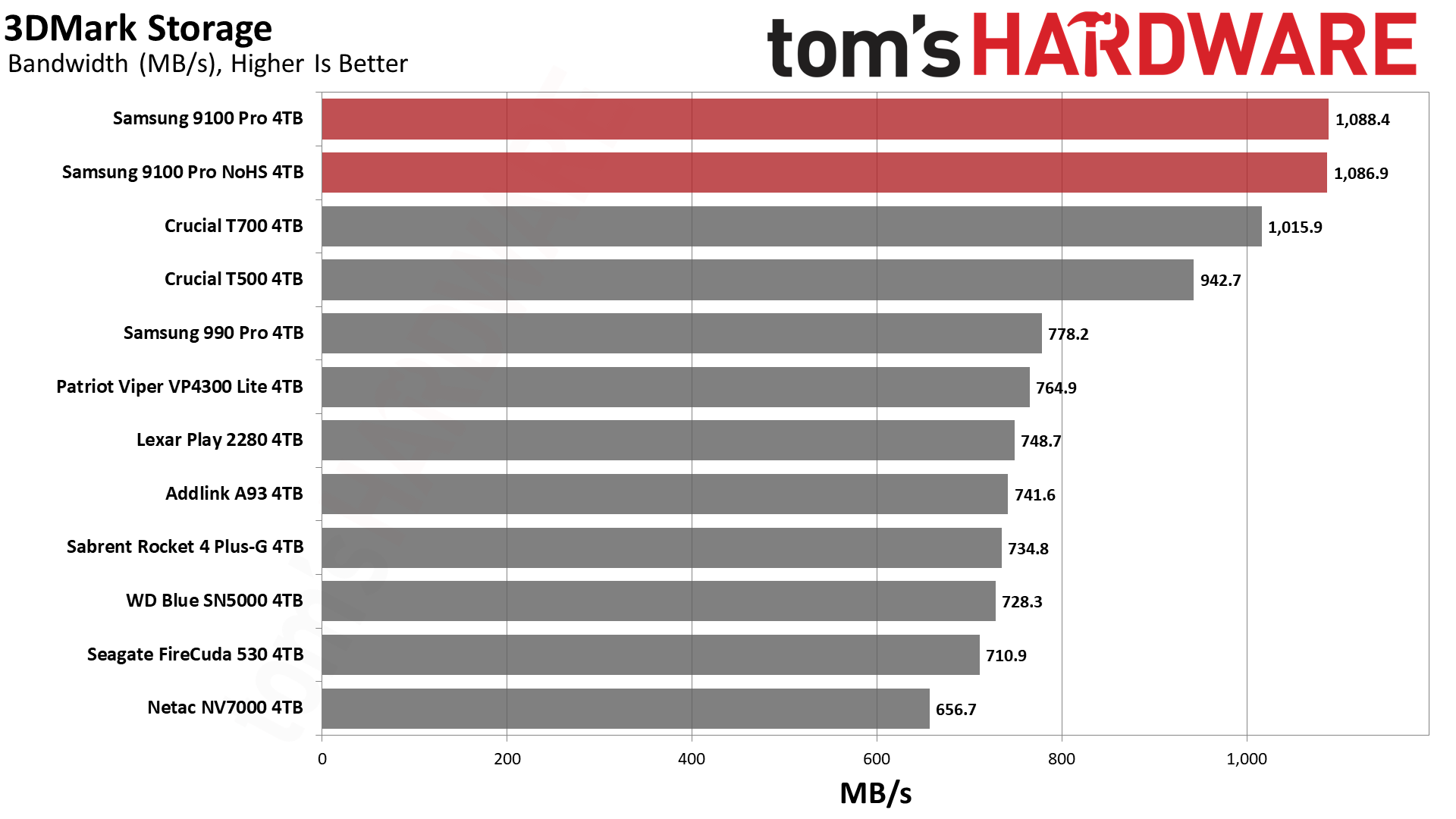
The 4TB 9100 Pro fares much better than its 2TB counterpart in 3DMark. In some respects it would be more correct to say that the competition performs worse at 4TB. 4TB is still a lot of flash, and operating it at higher speeds can be challenging. Given that Phison’s controller technology is produced in an older node, it’s not surprising the T700 falls behind the 9100 Pro. If we had a 4TB drive based on Silicon Motion’s SM2508 to test we would probably discover that it is a better competitor. Many other drives on this list, like the T500, have only four flash channels, so can also struggle with 4TB of flash.
Trace Testing — PCMark 10 Storage Benchmark
PCMark 10 is a trace-based benchmark that uses a wide-ranging set of real-world traces from popular applications and everyday tasks to measure the performance of storage devices. The results are particularly useful when analyzing drives for their use as primary/boot storage devices and in work environments.
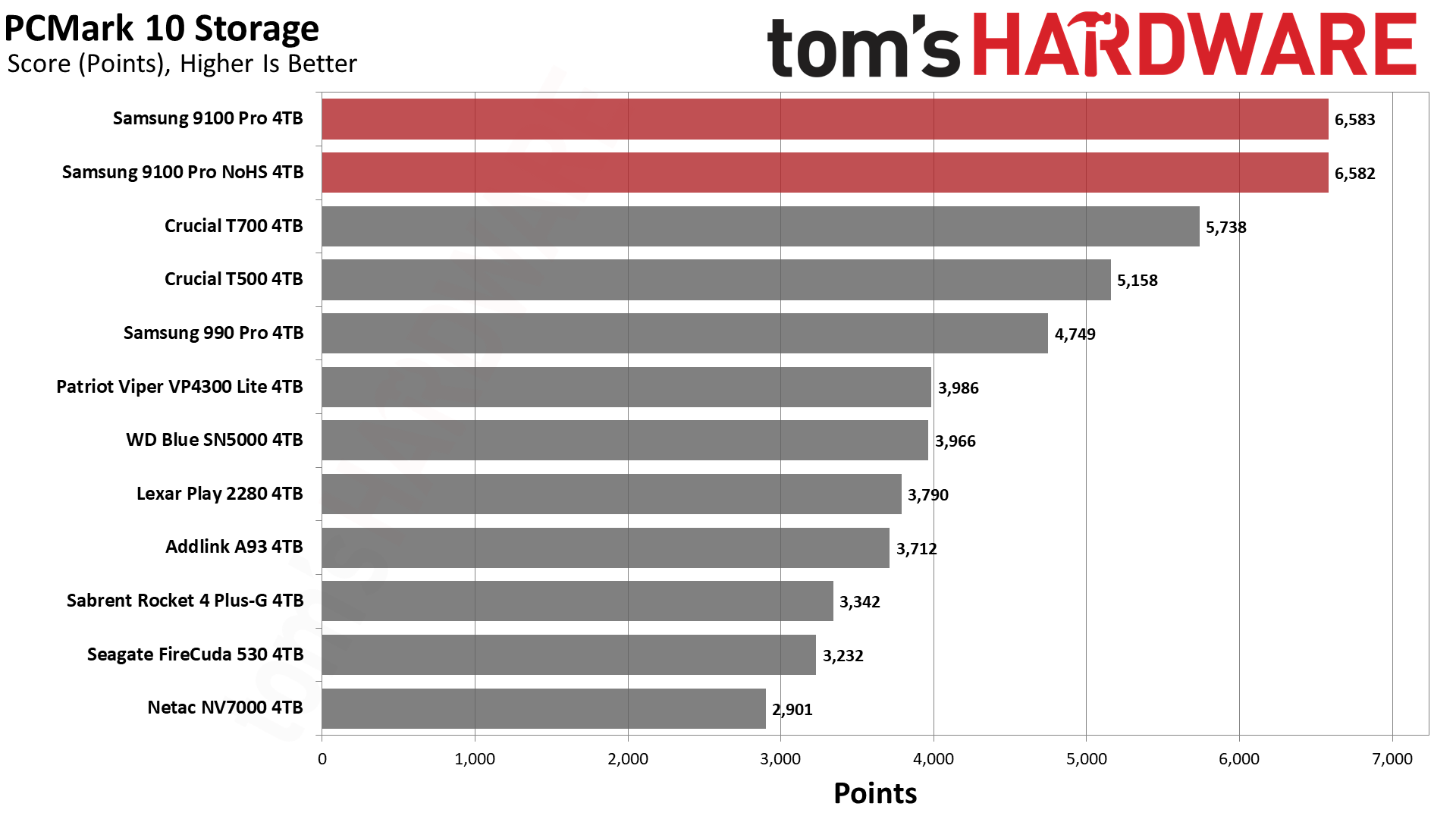
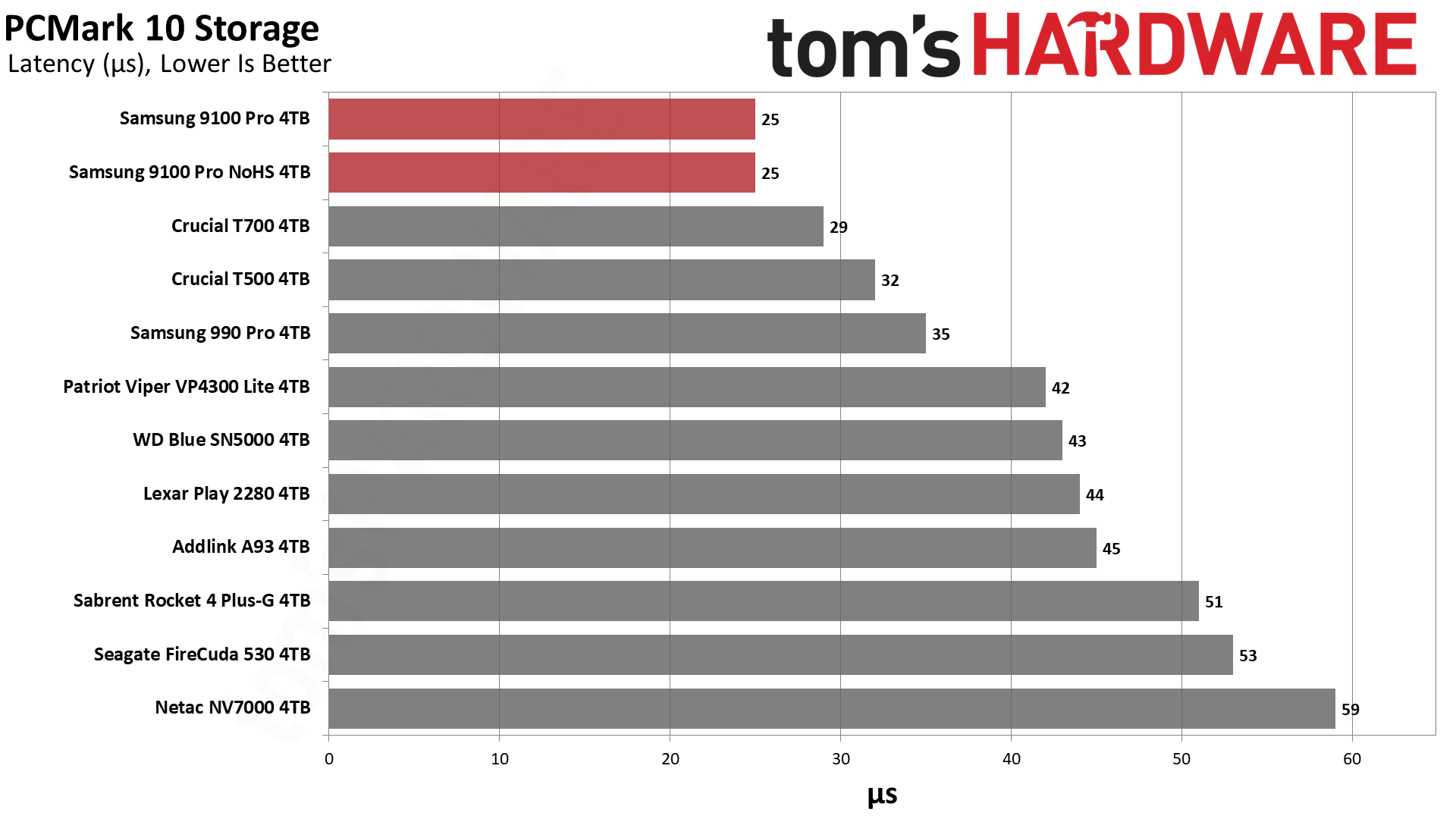
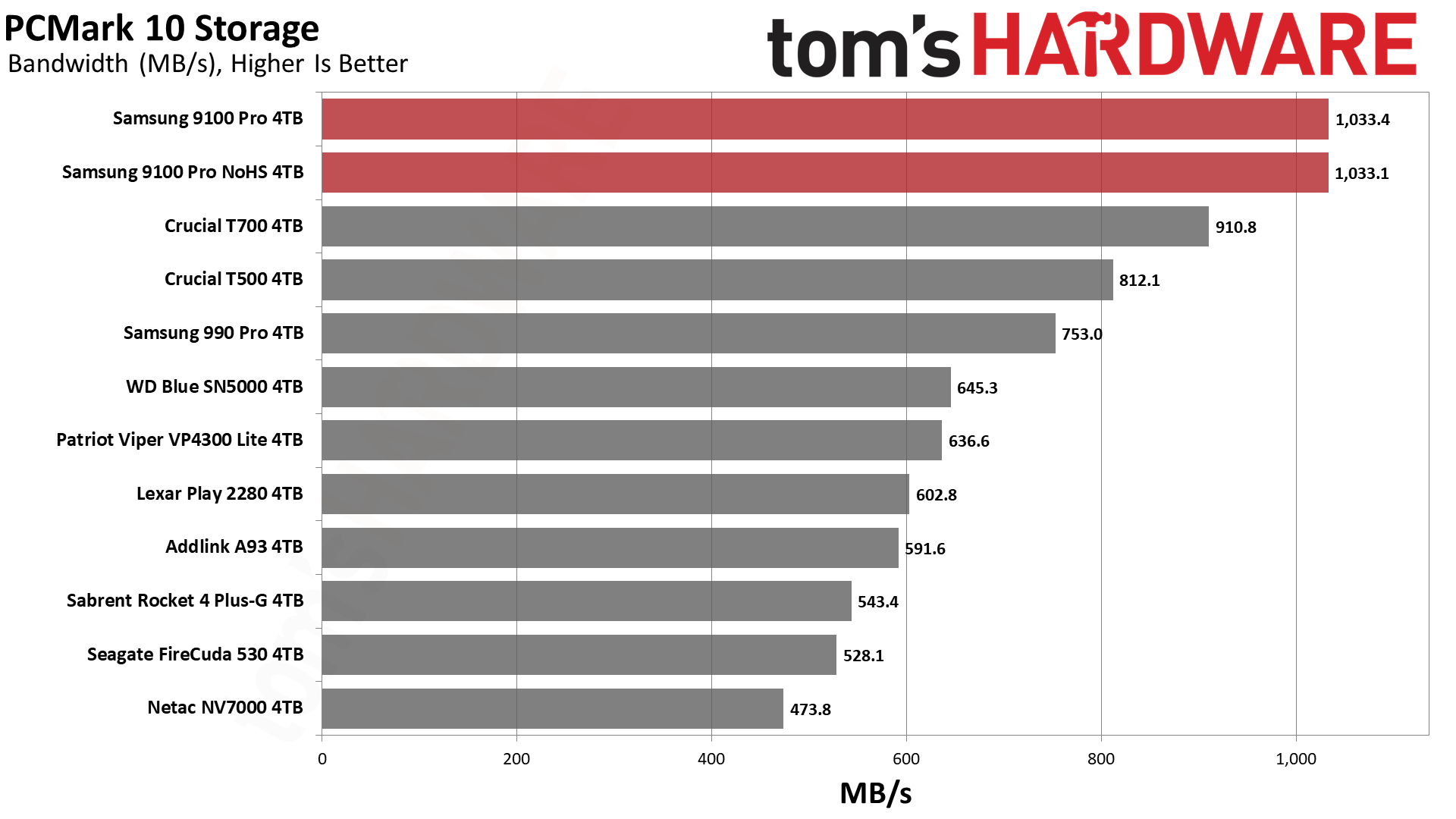
The 4TB 9100 pro dominates again in PCMark 10. If you want the very fastest 4TB drive on the market, there is little competition that can stand up to it.
Get Tom's Hardware's best news and in-depth reviews, straight to your inbox.
Console Testing — PlayStation 5 Transfers
The PlayStation 5 is capable of taking one additional PCIe 4.0 or faster SSD for extra game storage. While any 4.0 drive will technically work, Sony recommends drives that can deliver at least 5,500 MB/s of sequential read bandwidth for optimal performance. In our testing, PCIe 5.0 SSDs don’t bring much to the table and generally shouldn’t be used in the PS5, especially as they may require additional cooling. Check our Best PS5 SSDs article for more information.
Our testing utilizes the PS5’s internal storage test and manual read/write tests with over 192GB of data both from and to the internal storage. Throttling is prevented where possible to see how each drive operates under ideal conditions. While game load times should not deviate much from drive to drive, our results can indicate which drives may be more responsive in long-term use.

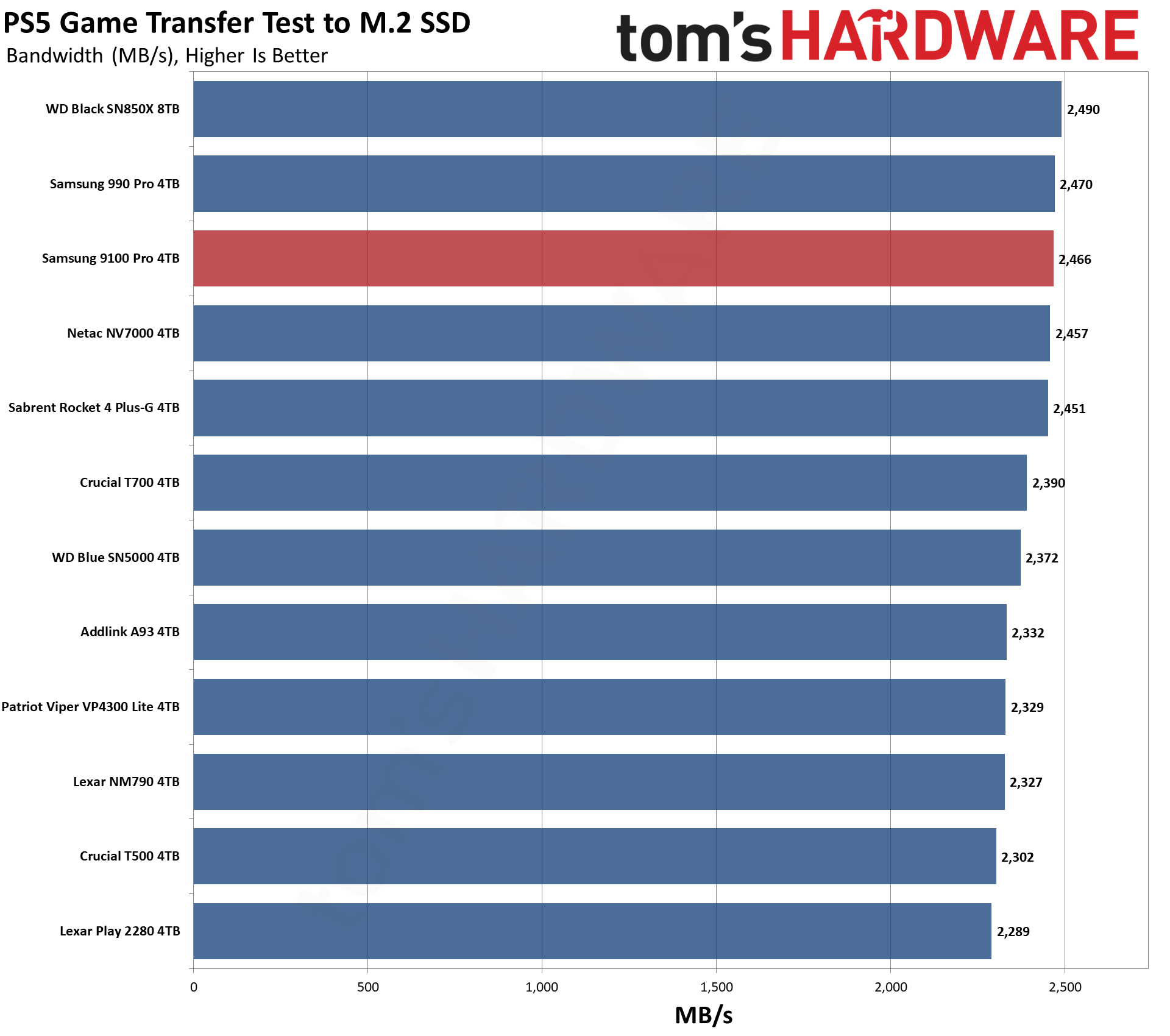
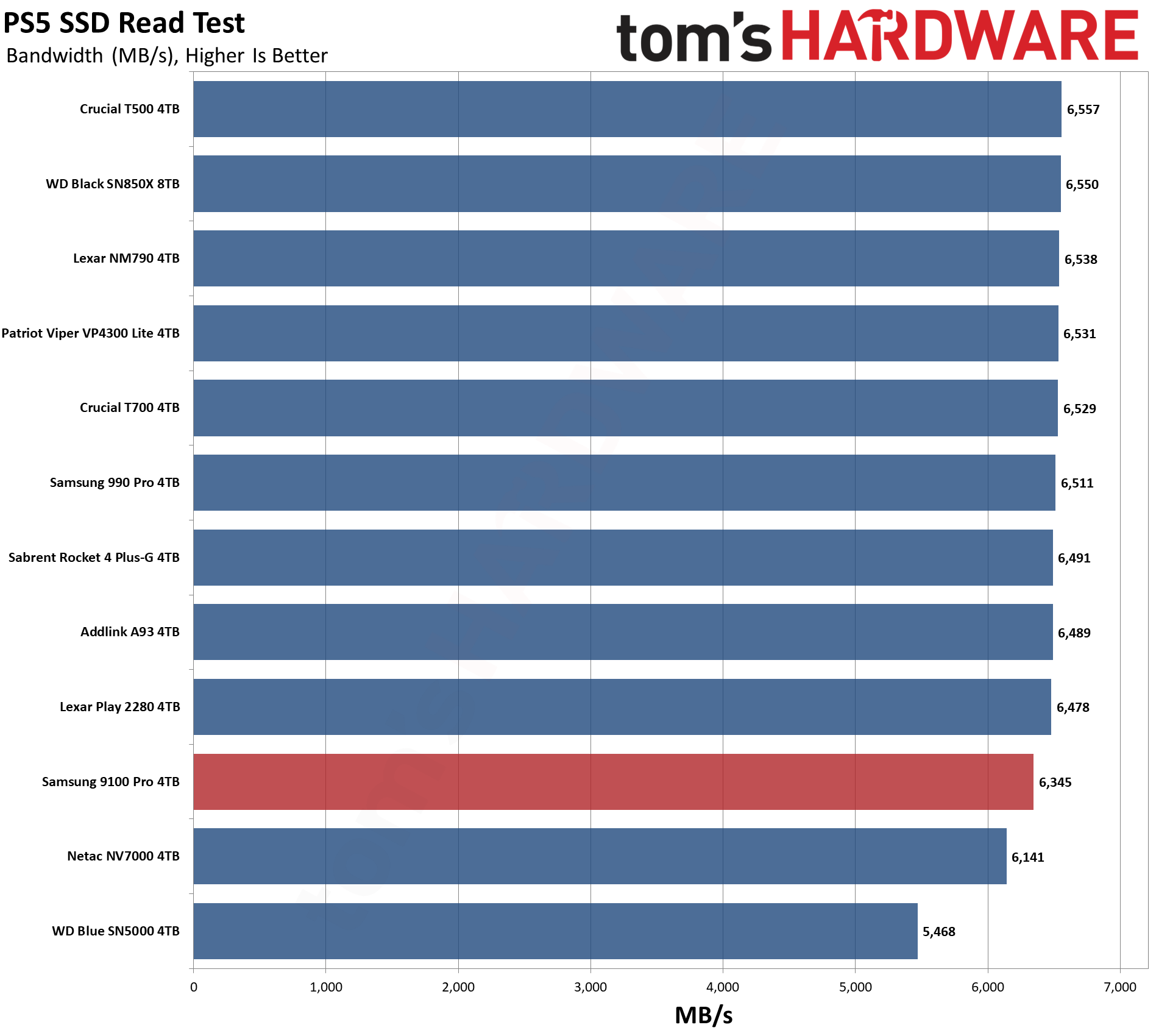
4TB is quite nice to have for extra game space on the PS5, but the 9100 Pro is overkill in the extreme. We would recommend a standard PCIe 4.0 SSD drive for this type of usage, although the 9100 Pro would work just fine.
Transfer Rates — DiskBench
We use the DiskBench storage benchmarking tool to test file transfer performance with a custom, 50GB dataset. We write 31,227 files of various types, such as pictures, PDFs, and videos to the test drive, then make a copy of that data to a new folder, and follow up with a reading test of a newly-written 6.5GB zip file. This is a real world type workload that fits into the cache of most drives.
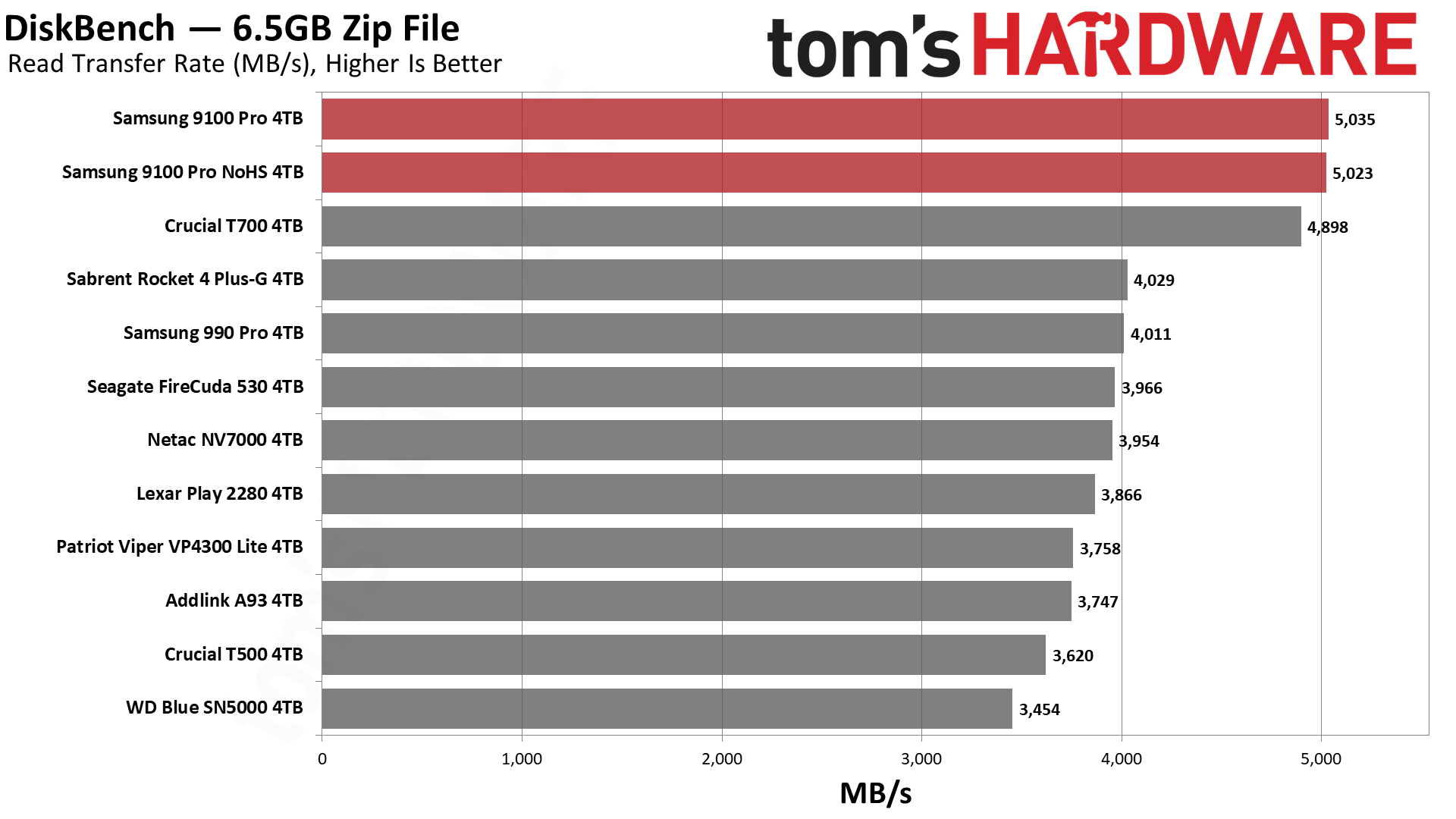
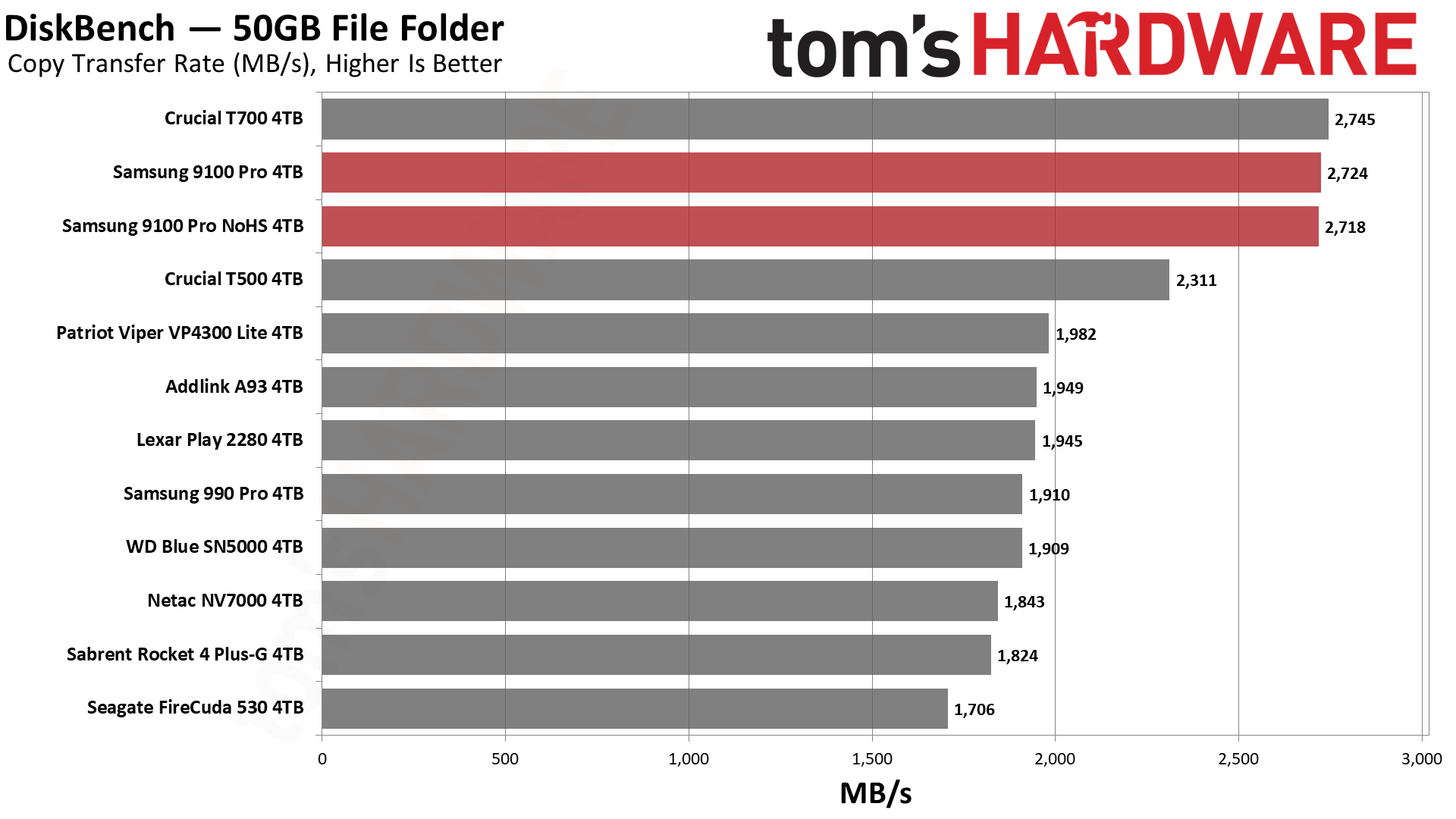
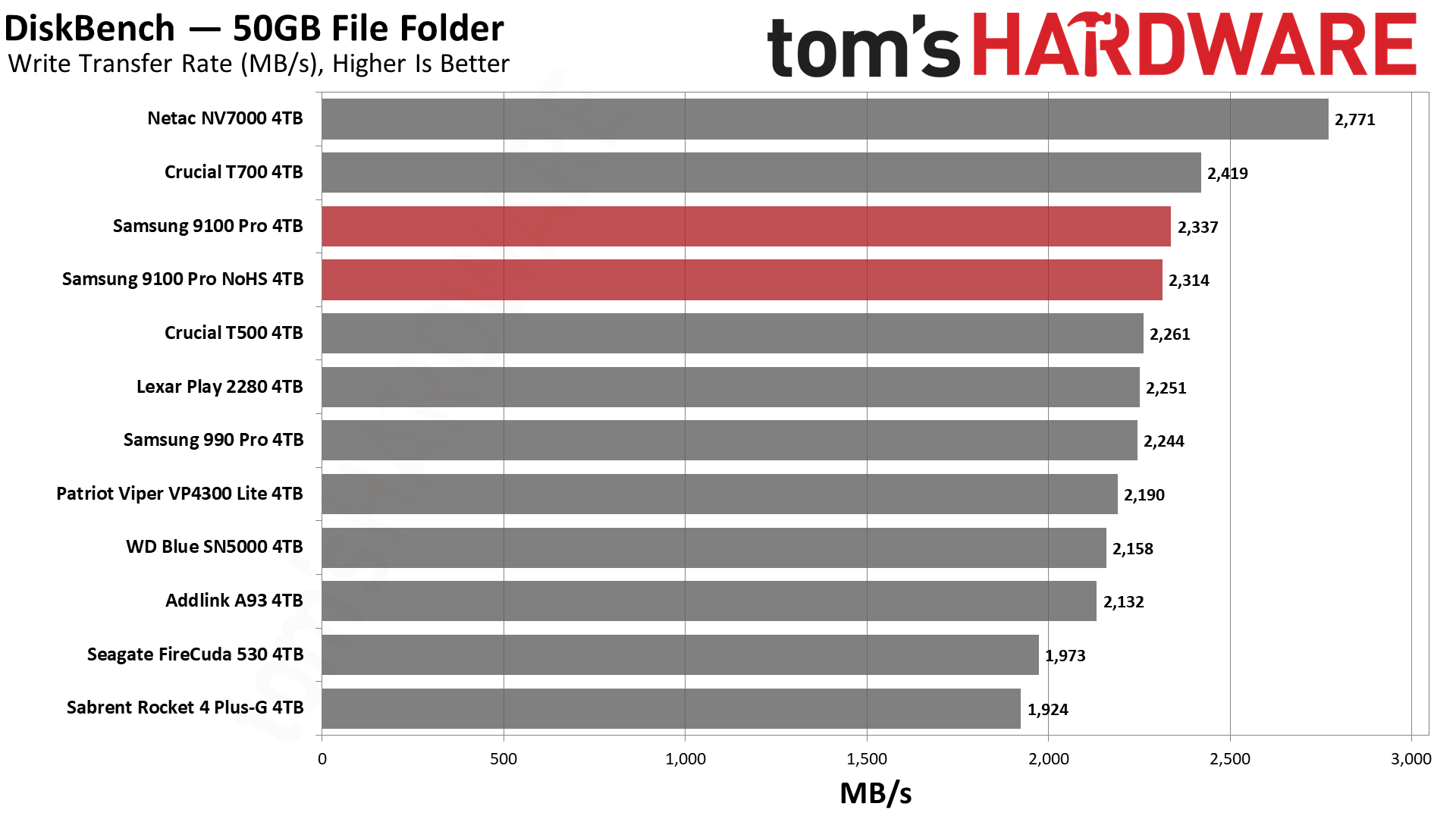
The 9100 Pro is also more impressive at 4TB than 2TB when looking at file transfers. While it’s not a lot faster than the 2TB, its performance in comparison to its 4TB peers is more respectable. That said, the T700 generally performs worse than the T705 and other top tier E26-based drives, so we’d expect the 9100 Pro to still fall short of the best PCIe 5.0 SSDs in this test. Pricing and availability are factors, however, when it comes to the fastest drives at 4TB.
Synthetic Testing — ATTO / CrystalDiskMark
ATTO and CrystalDiskMark (CDM) are free and easy-to-use storage benchmarking tools that SSD vendors commonly use to assign performance specifications to their products. Both of these tools give us insight into how each device handles different file sizes and at different queue depths for both sequential and random workloads.
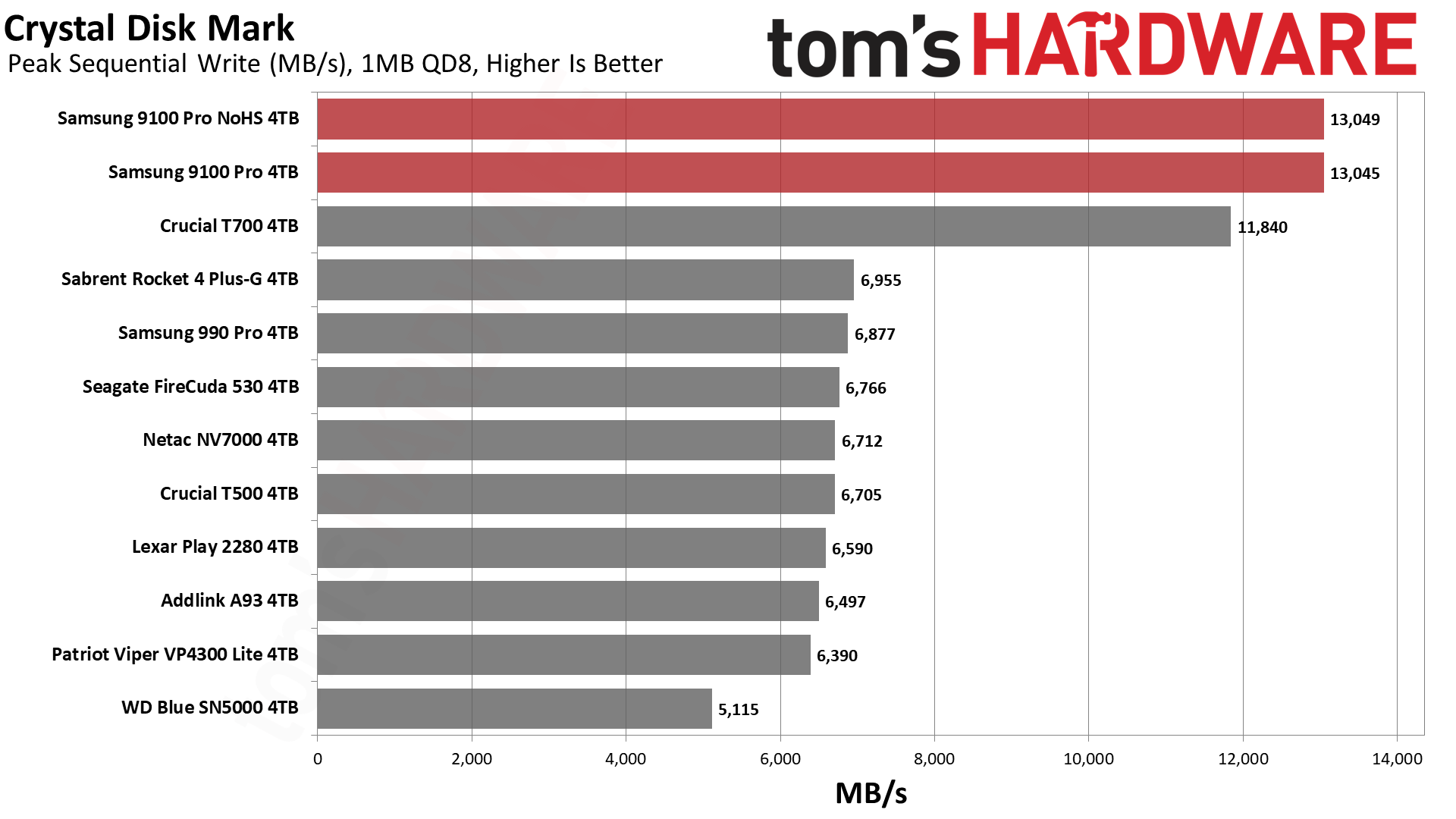
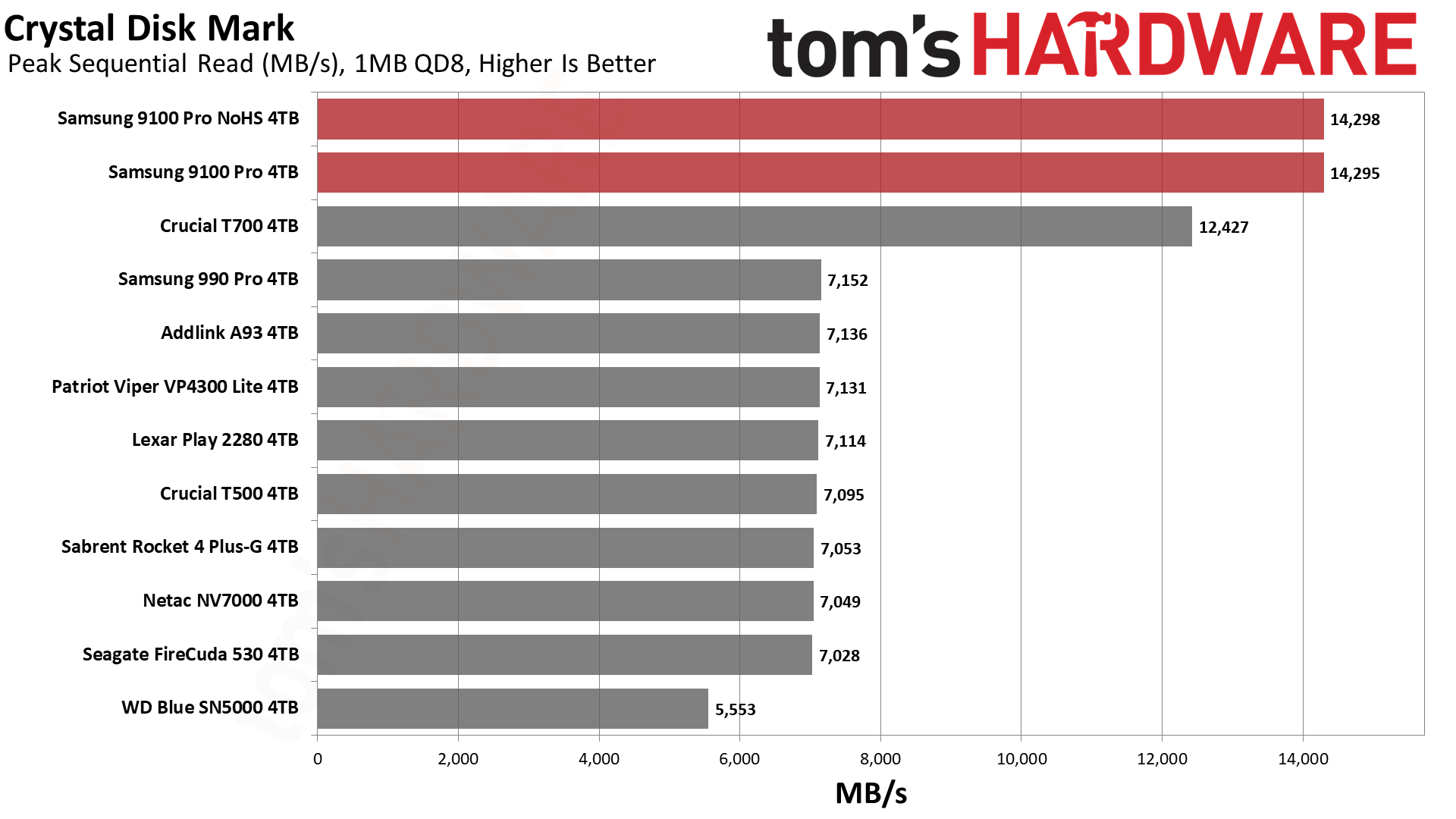
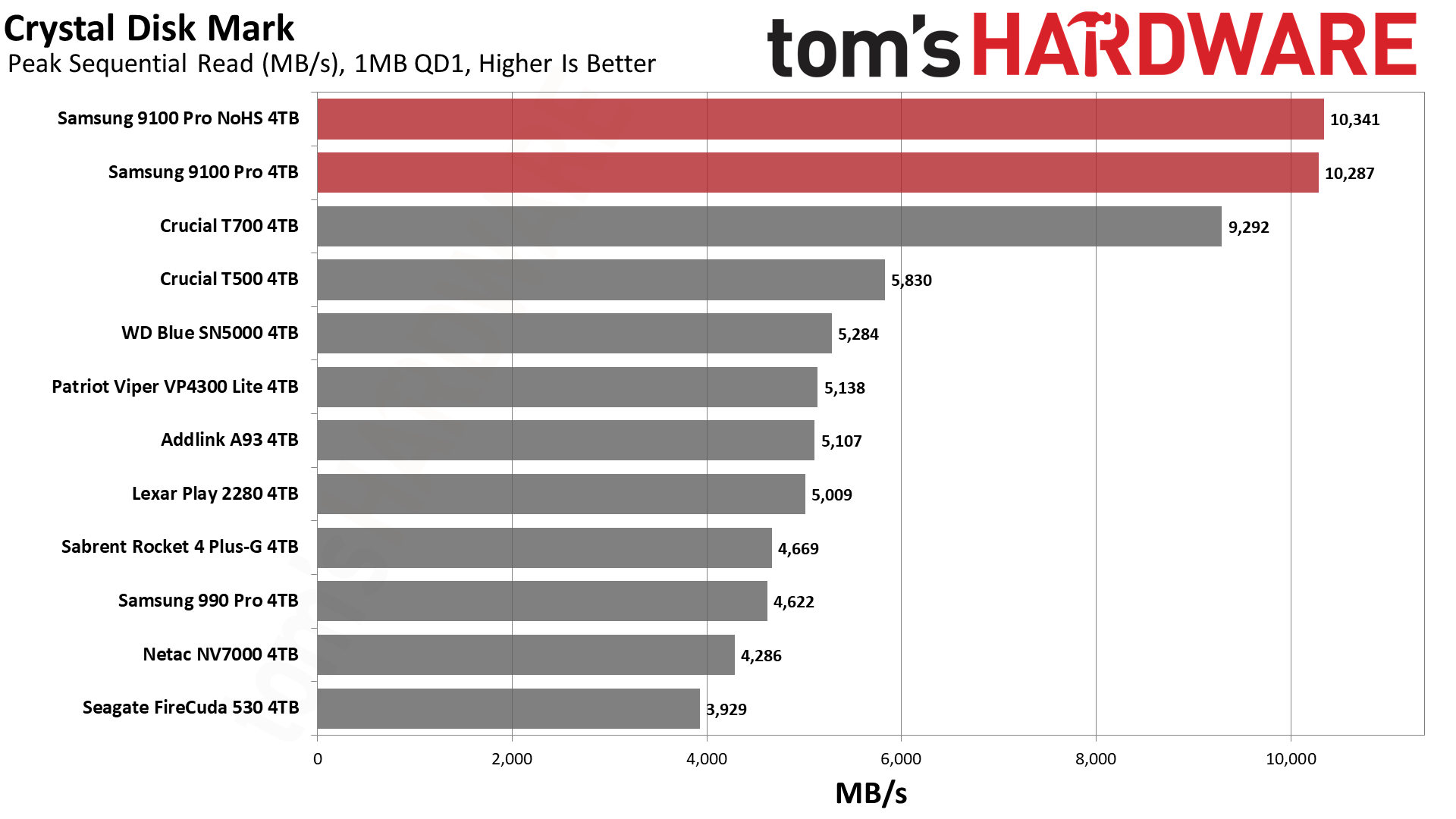

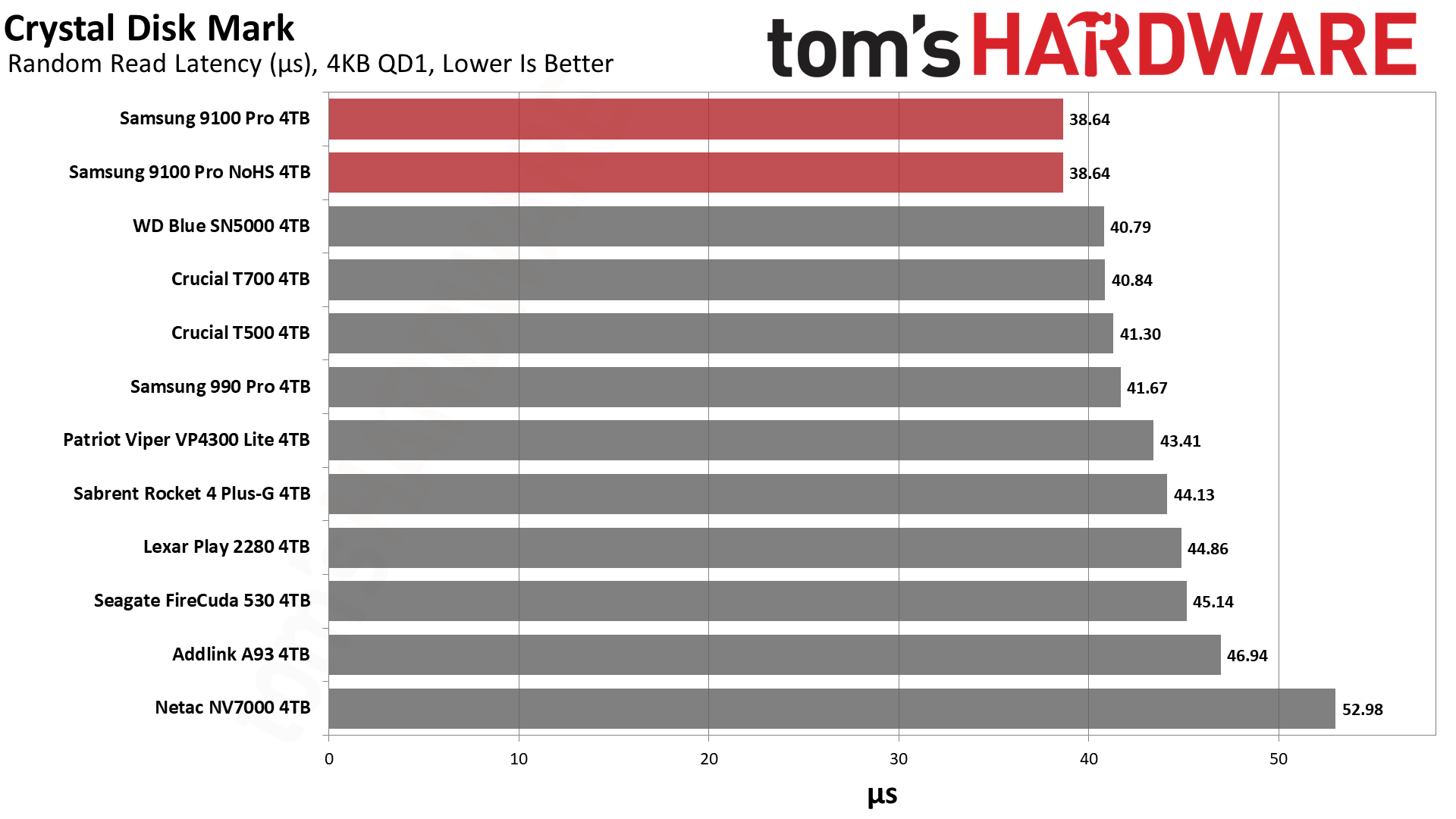
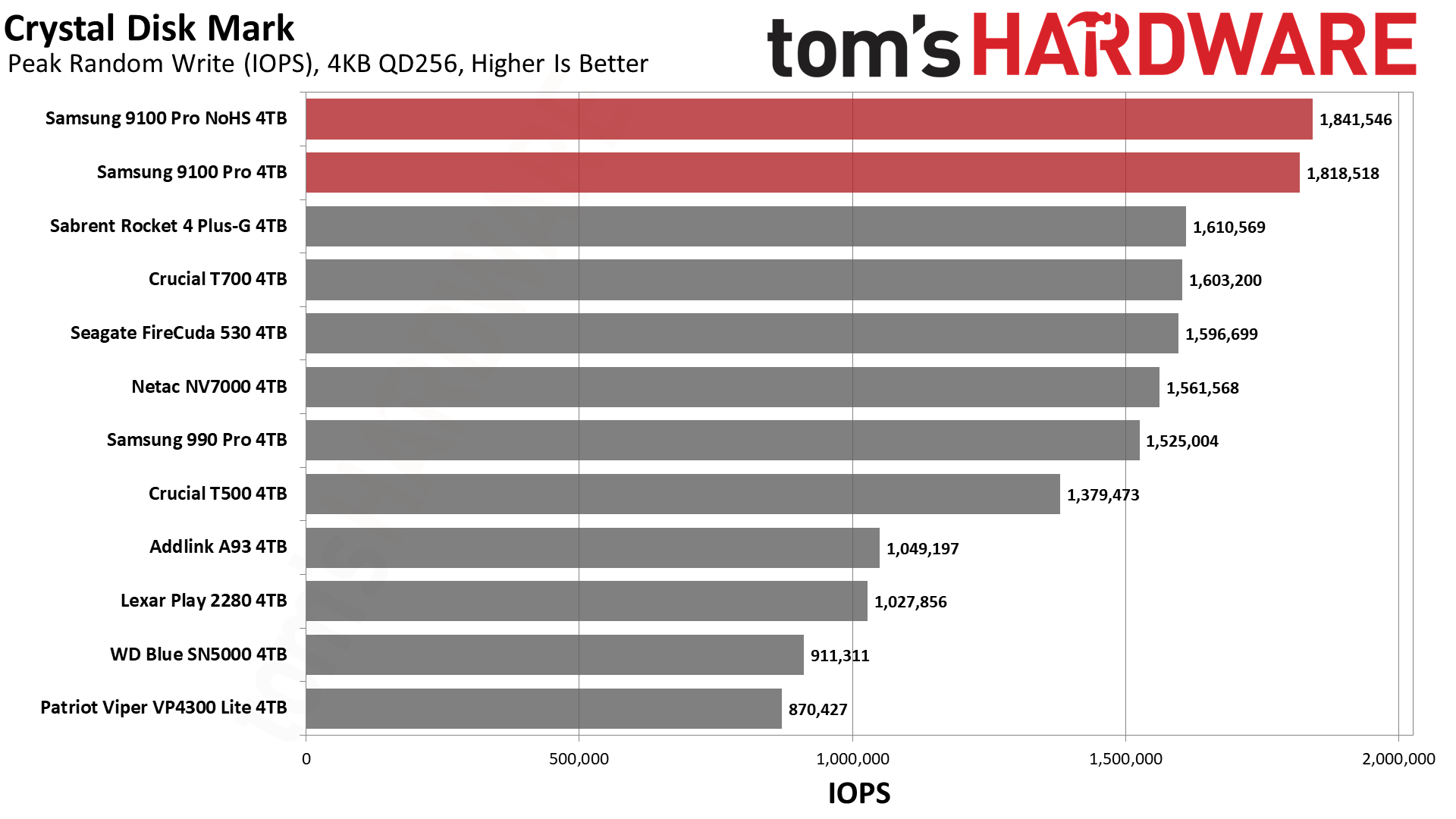
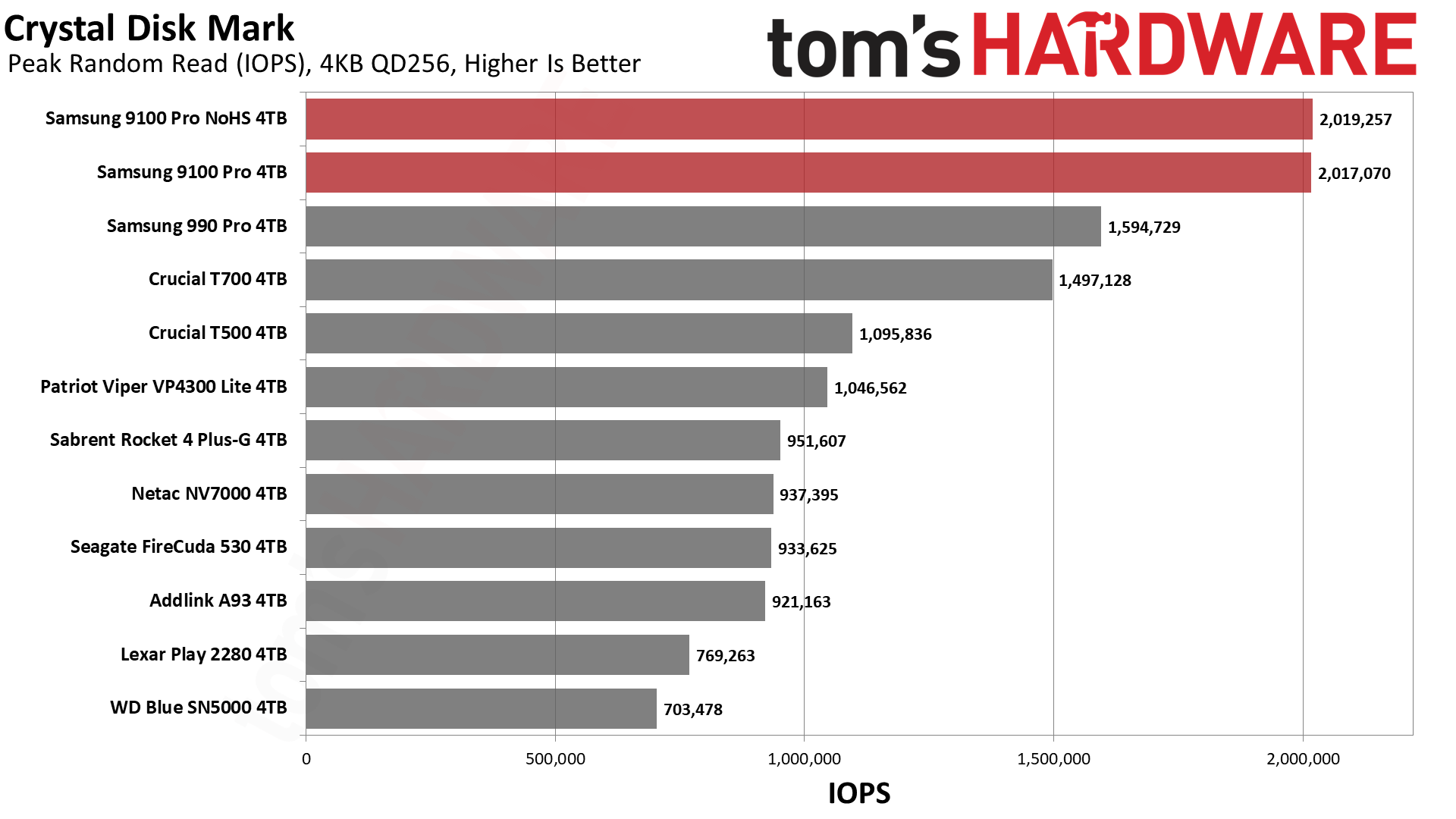
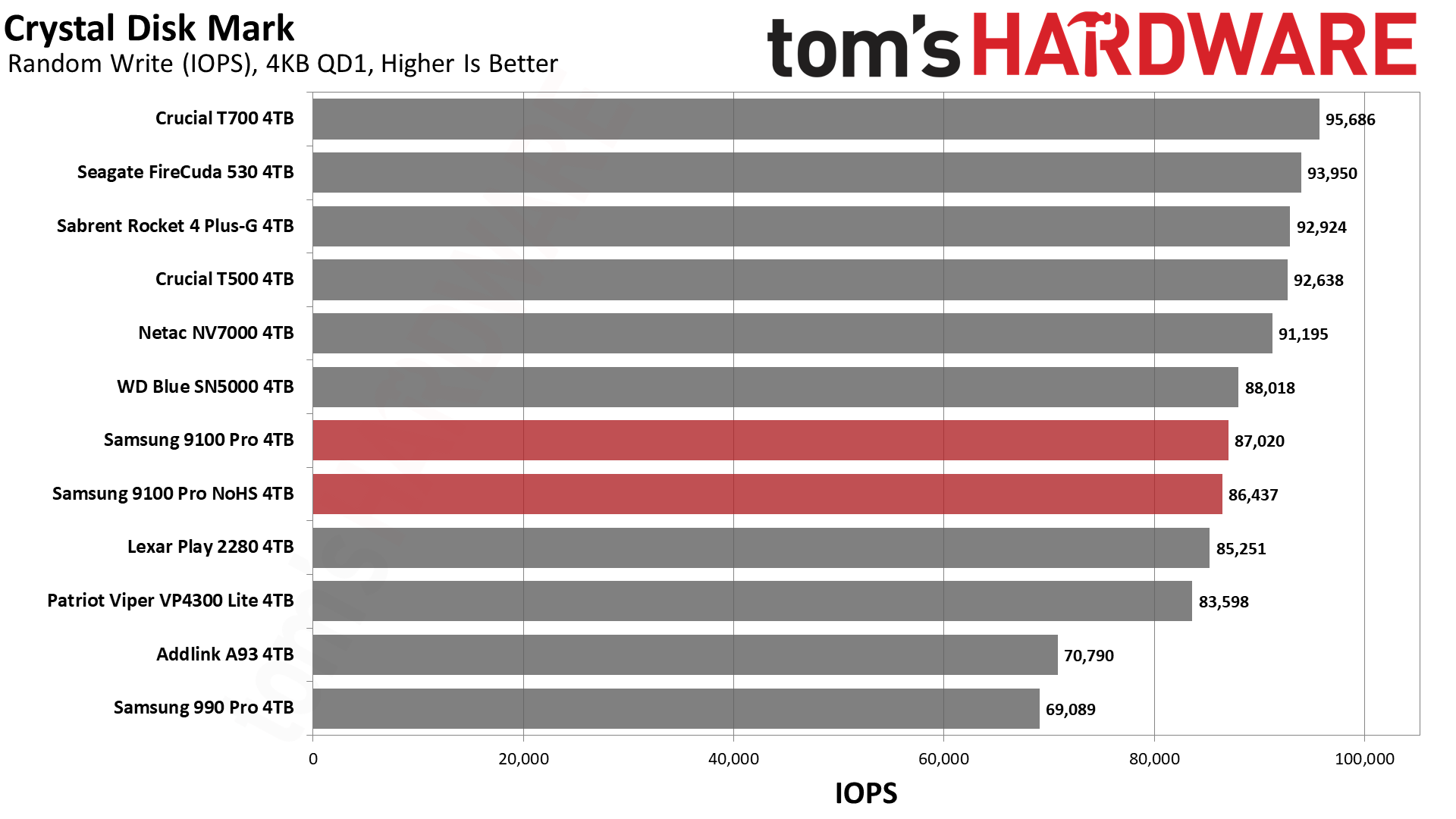
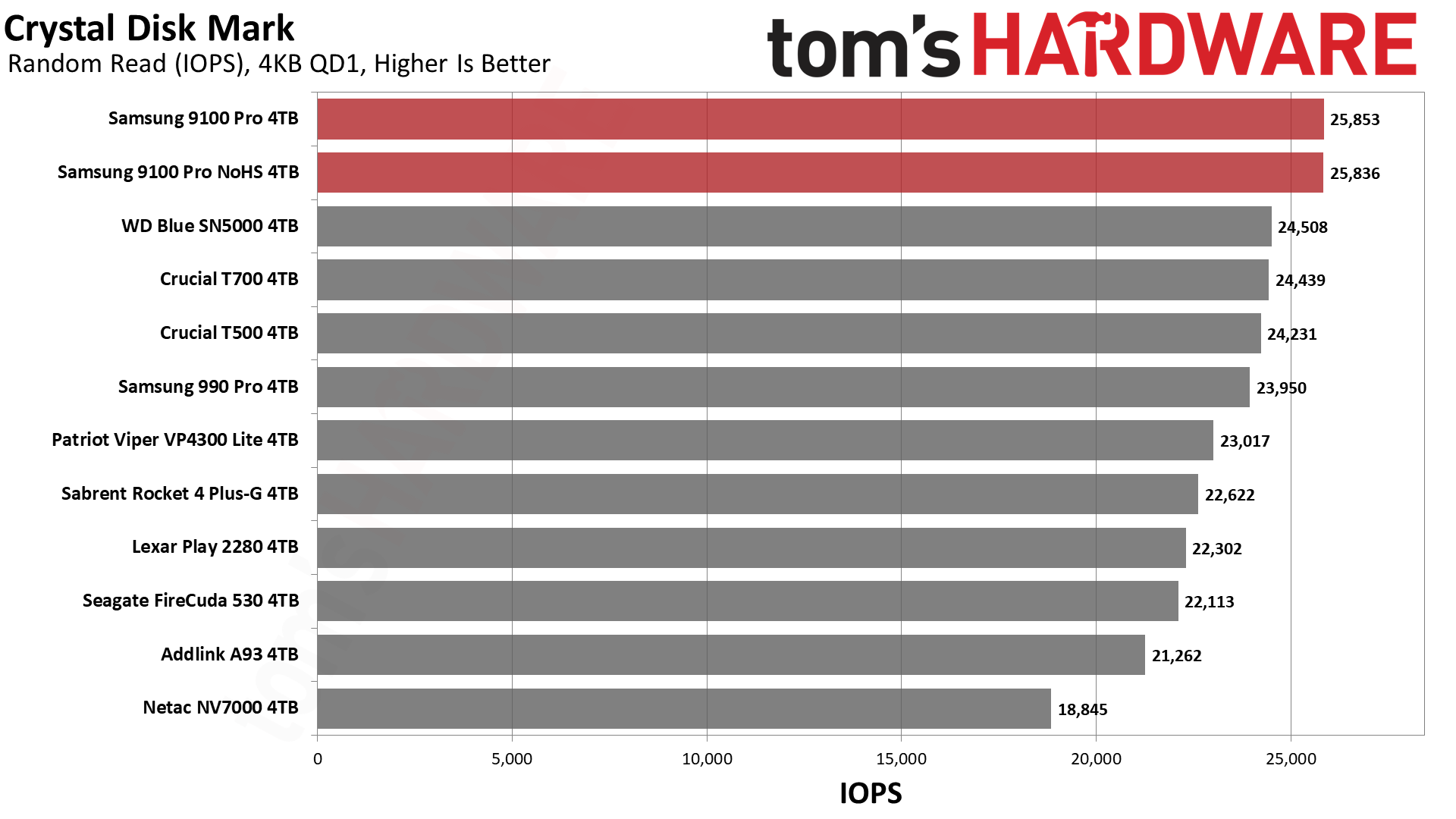
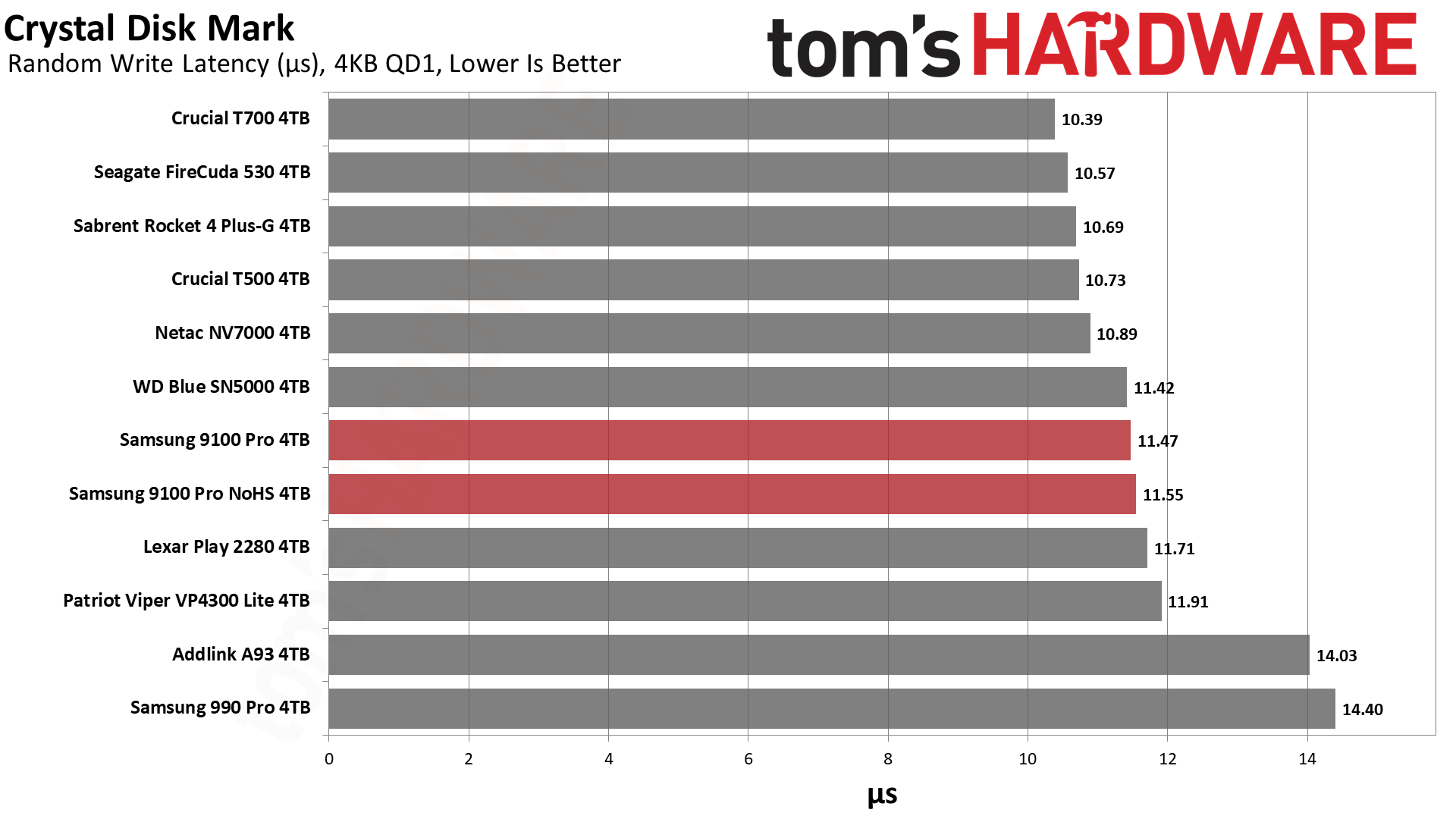
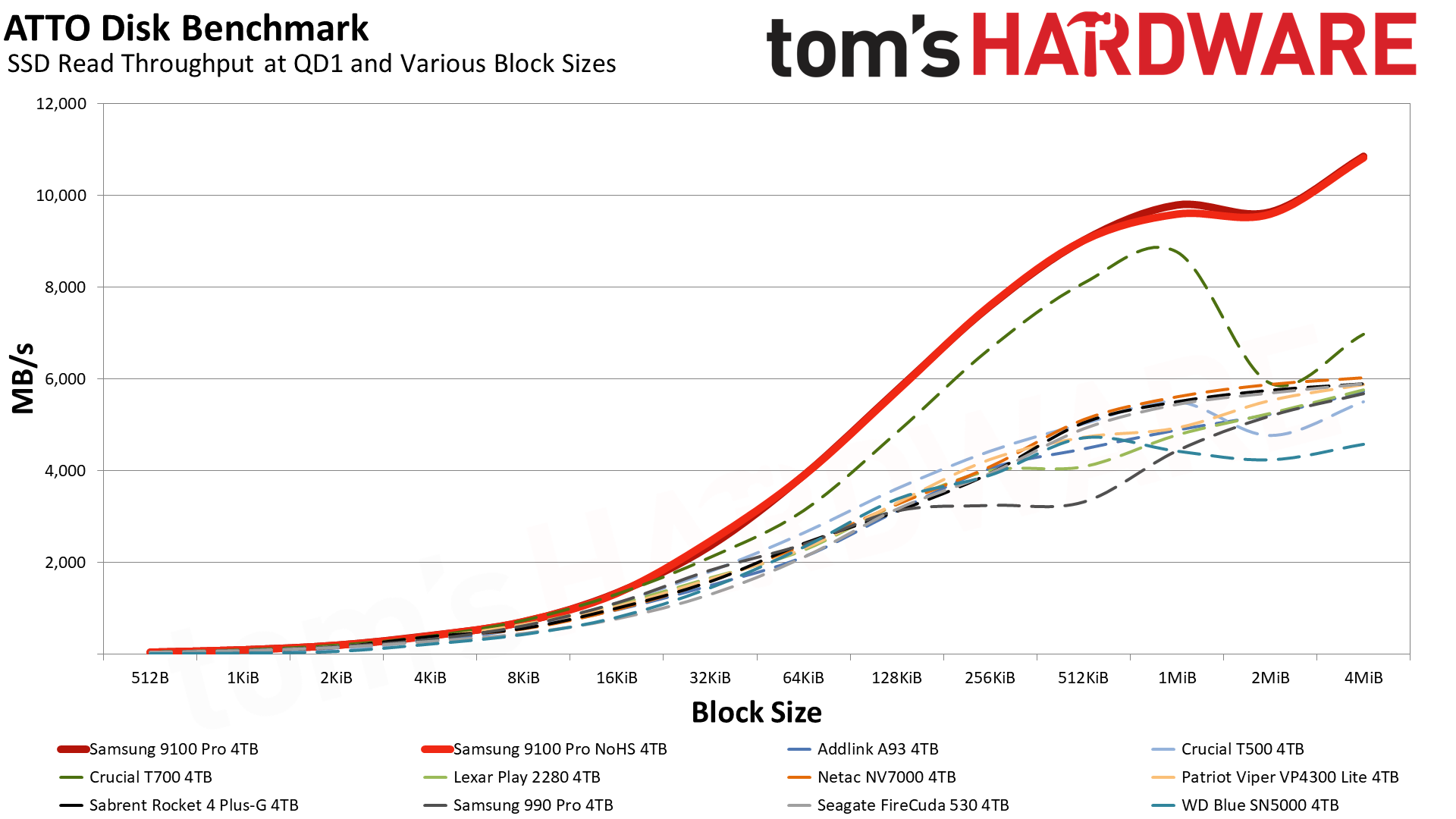

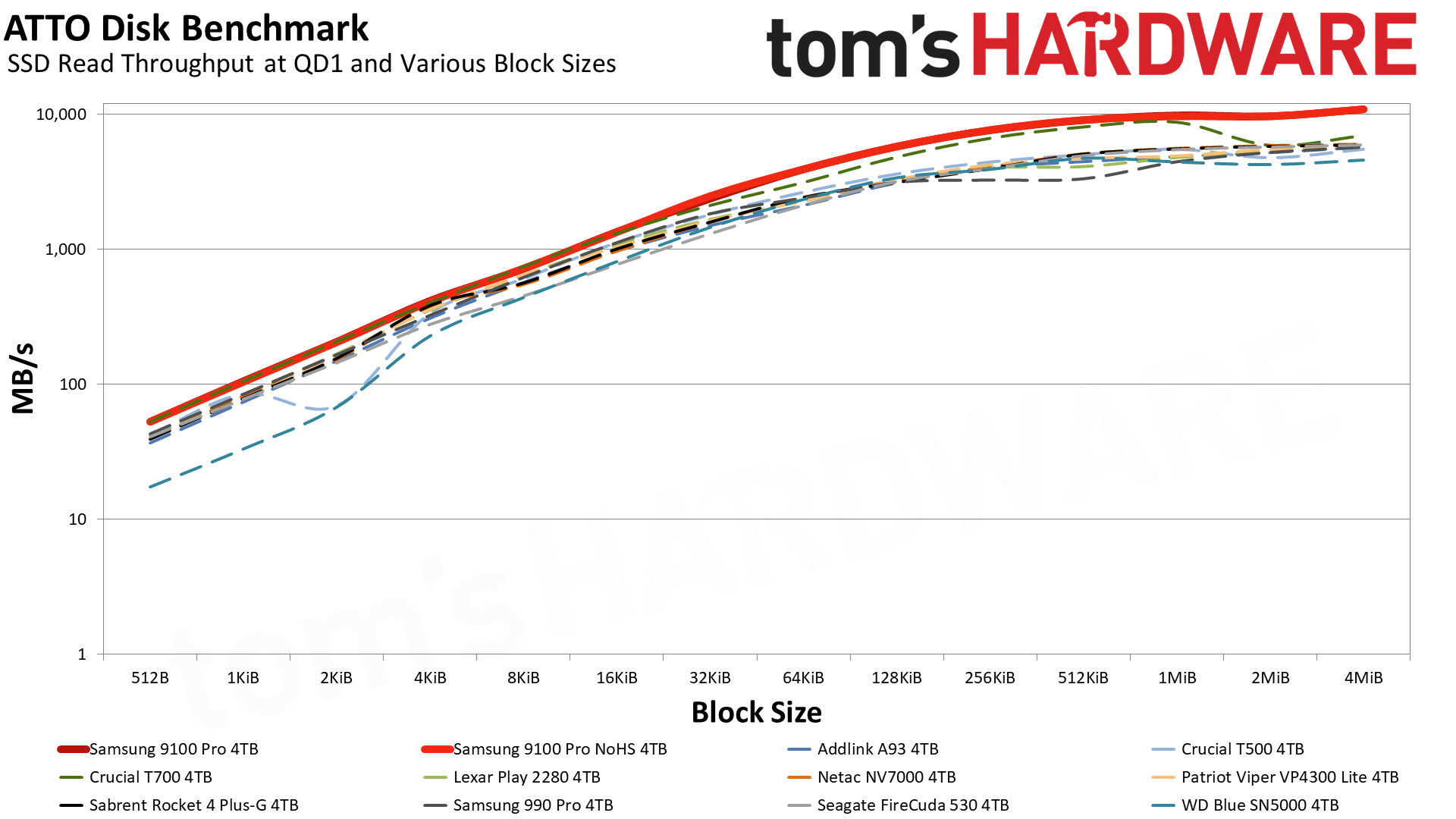
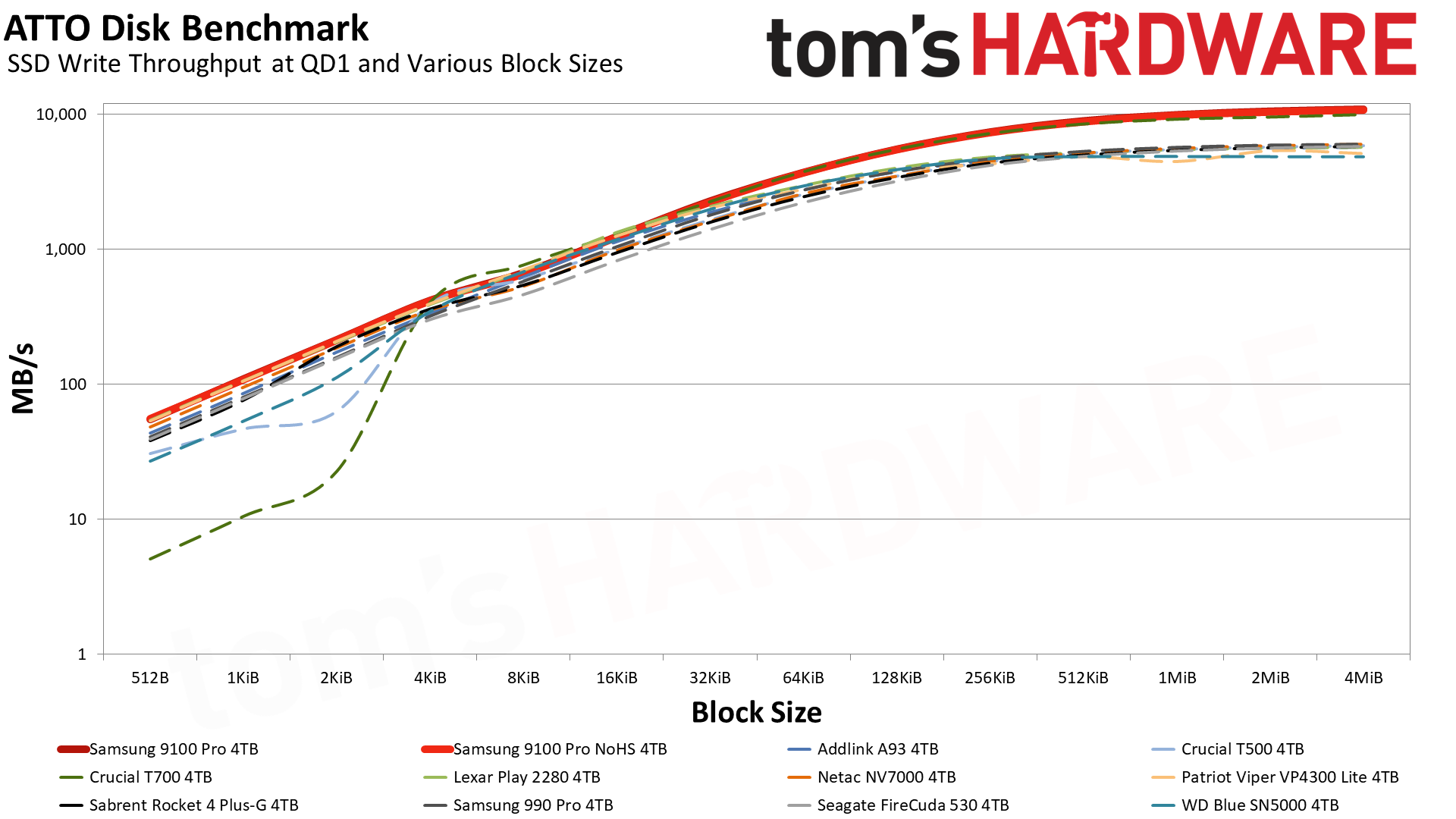
The 4TB 9100 Pro performs admirably in ATTO at all block sizes and this is reflected in the CDM sequential results. Again, its read performance is especially good and specifically it stands out at QD1. Many everyday operations rely on this rather than random 4KB performance, despite popular opinion. That said, the drive also has decently low 4KB random read latency at QD1 and its write latency is acceptable. We do think newer drives will beat it here. The WD Black SN7100, for one, is expecting a 4TB rollout at some point and its excellent random read latency would likely one-up the 9100 Pro as it does in the 2TB comparison.
Sustained Write Performance and Cache Recovery
Official write specifications are only part of the performance picture. Most SSDs implement a write cache, which is a fast area of pseudo-SLC (single-bit) programmed flash that absorbs incoming data. Sustained write speeds can suffer tremendously once the workload spills outside of the cache and into the "native" TLC (three-bit) or QLC (four-bit) flash. Performance can suffer even more if the drive is forced to fold, which is the process of migrating data out of the cache in order to free up space for further incoming data.
We use Iometer to hammer the SSD with sequential writes for 15 minutes to measure both the size of the write cache and performance after the cache is saturated. We also monitor cache recovery via multiple idle rounds. This process shows the performance of the drive in various states as well as the steady state write performance.
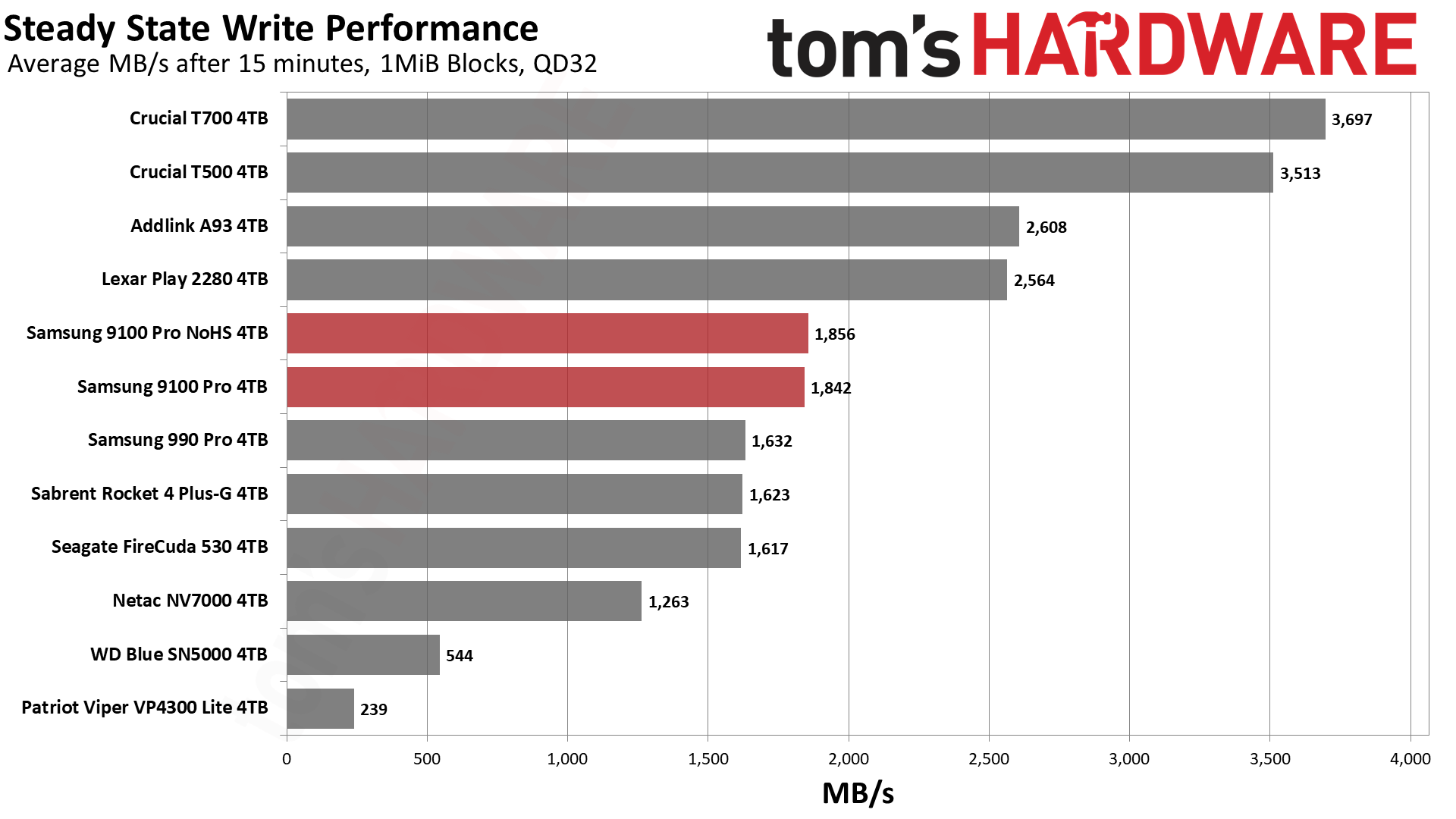
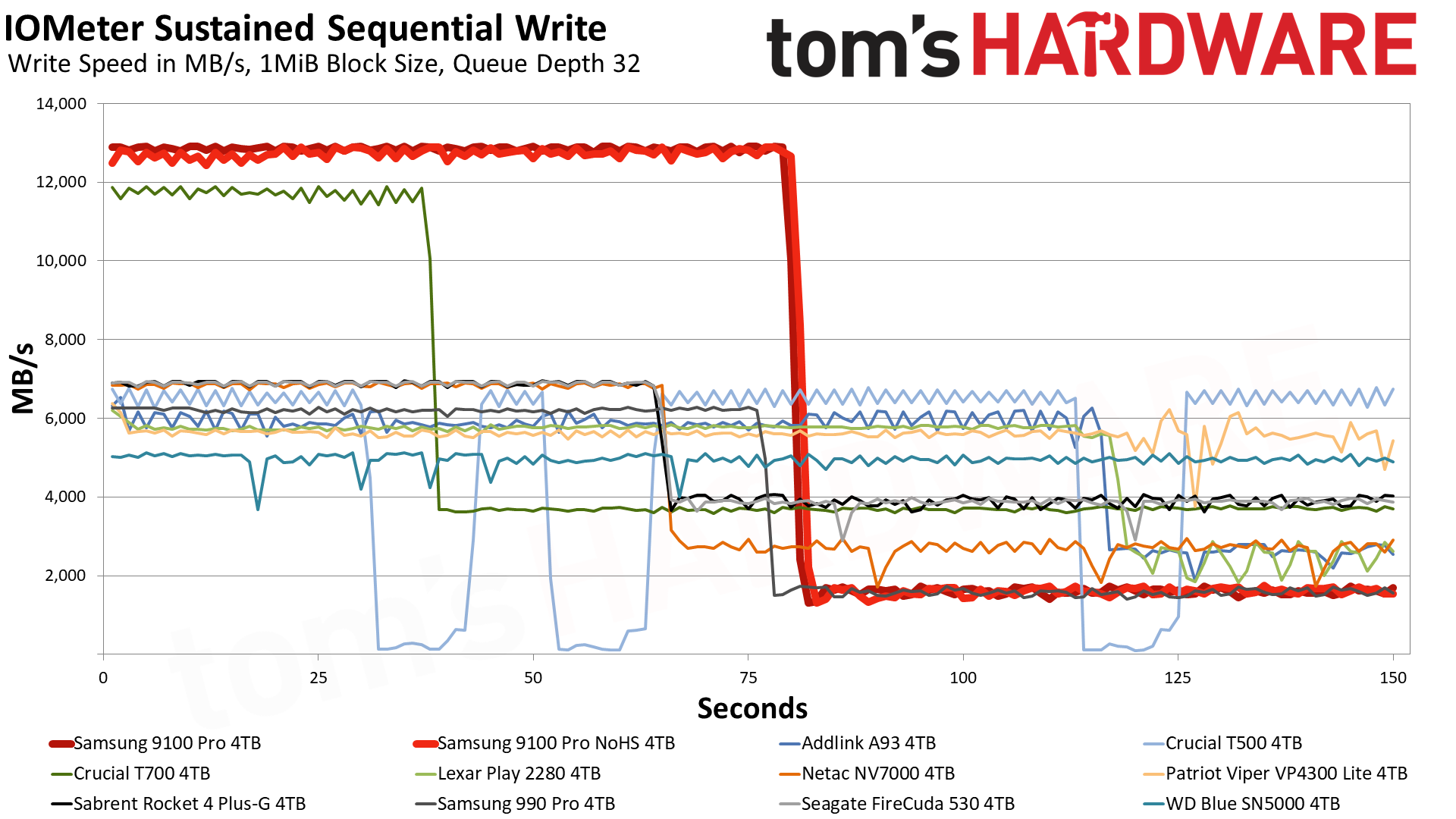
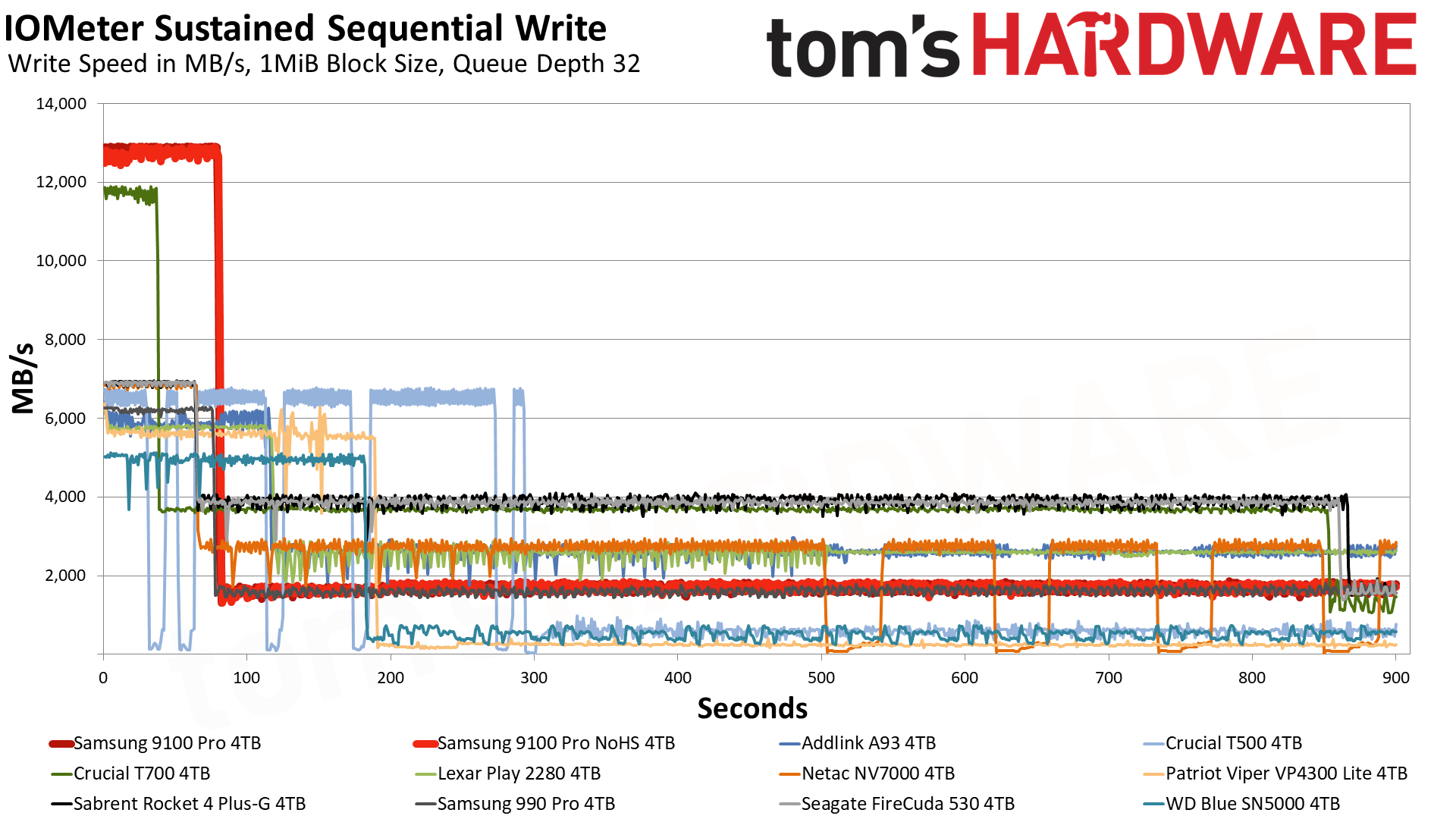
The 4TB 9100 Pro performs at around the same level as the 2TB in our write saturation test. We don't have the smaller 1TB to test for comparison. Generally larger dies of the same generation will suffer some bit with small I/O latency due to extra addressing and also having an abundance of dies can increase overhead — we’ll have to wait for the 8TB SKU to fully explore this — but the 9100 Pro performs consistently across the two capacities we have today. The cache should be larger at 4TB, normally 442GB with 10GB static and 432GB dynamic, as there is more flash with which to work. Otherwise the performance states are similar.
Power Consumption and Temperature
We use the Quarch HD Programmable Power Module to gain a deeper understanding of power characteristics. Idle power consumption is an important aspect to consider, especially if you're looking for a laptop upgrade as even the best ultrabooks can have mediocre stock storage. Desktops may be more performance-oriented with less support for power-saving features, so we show the worst-case.
Some SSDs can consume watts of power at idle while better-suited ones sip just milliwatts. Average workload power consumption and max consumption are two other aspects of power consumption but performance-per-watt, or efficiency, is more important. A drive might consume more power during any given workload, but accomplishing a task faster allows the drive to drop into an idle state more quickly, ultimately saving energy.
For temperature recording we currently poll the drive’s primary composite sensor during testing with a ~22°C ambient. Our testing is rigorous enough to heat the drive to a realistic ceiling temperature.
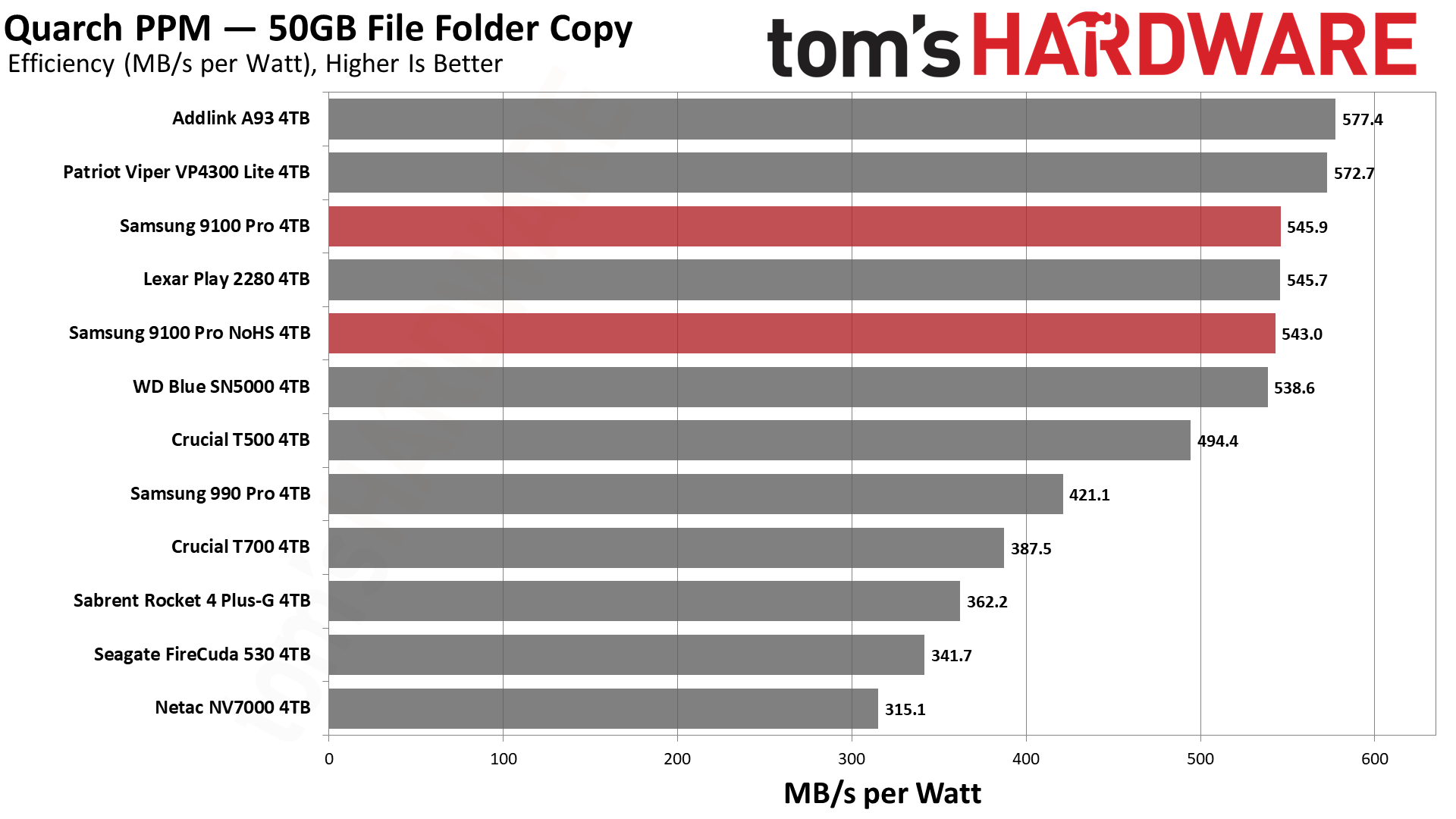
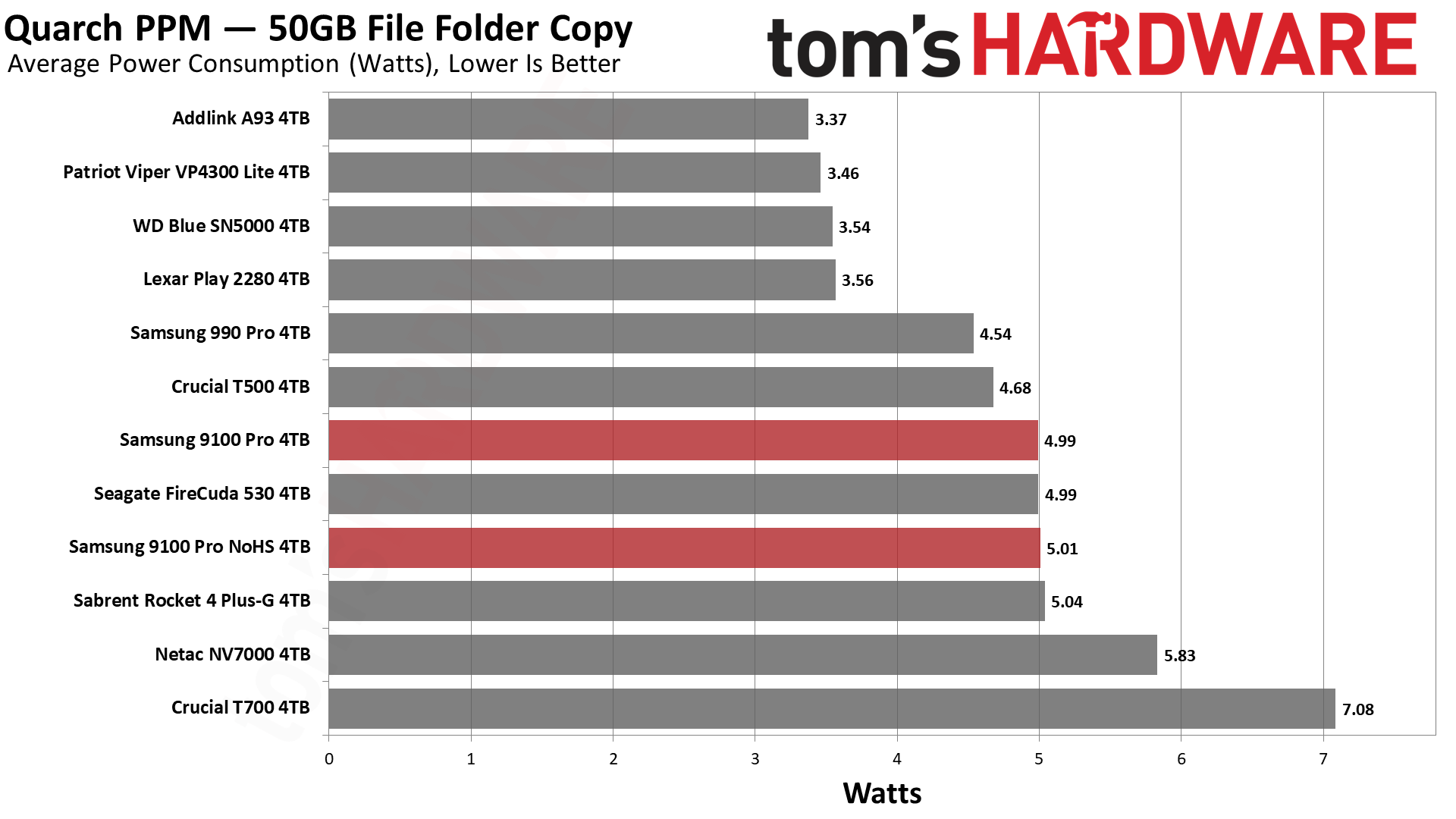
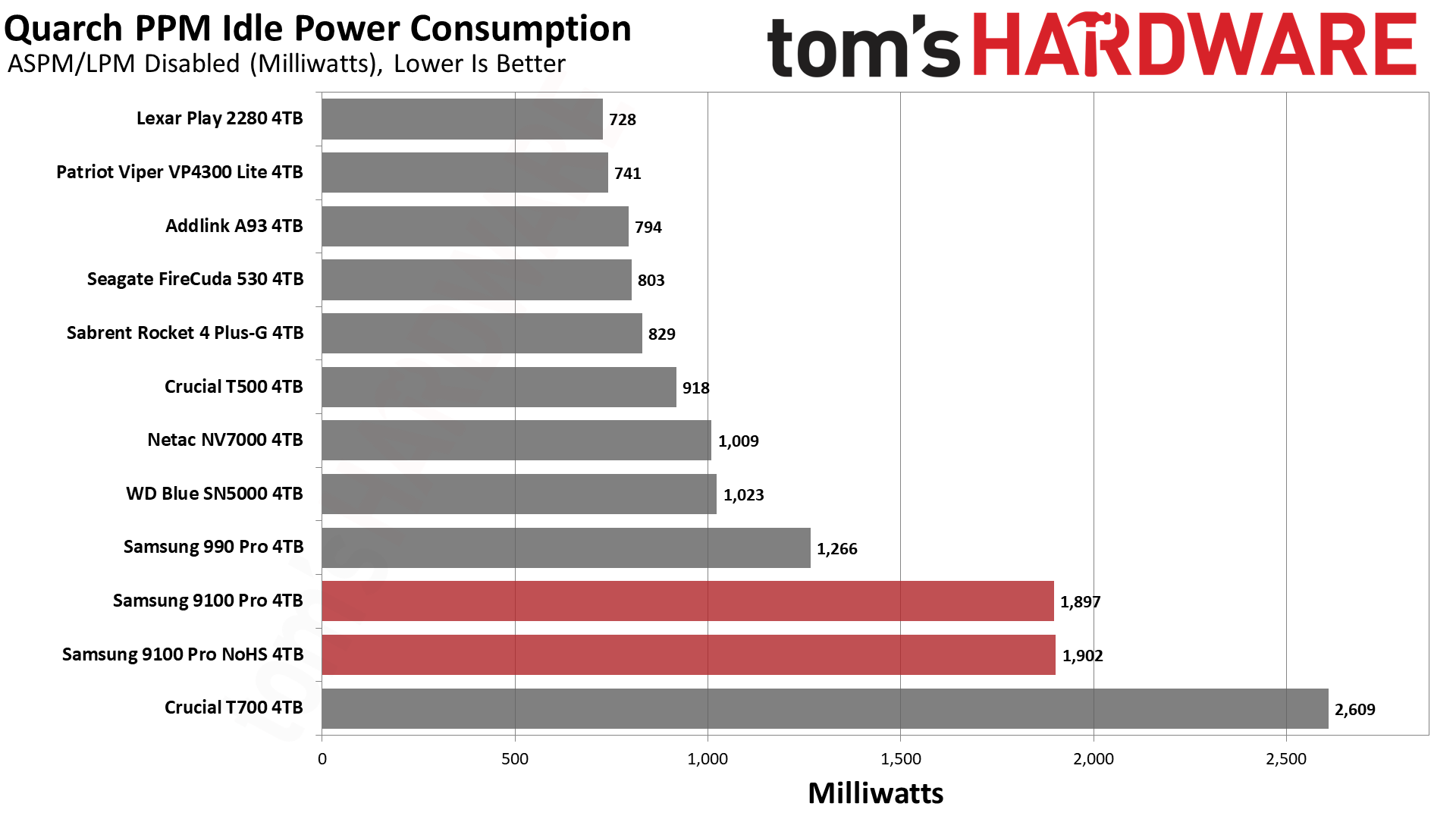
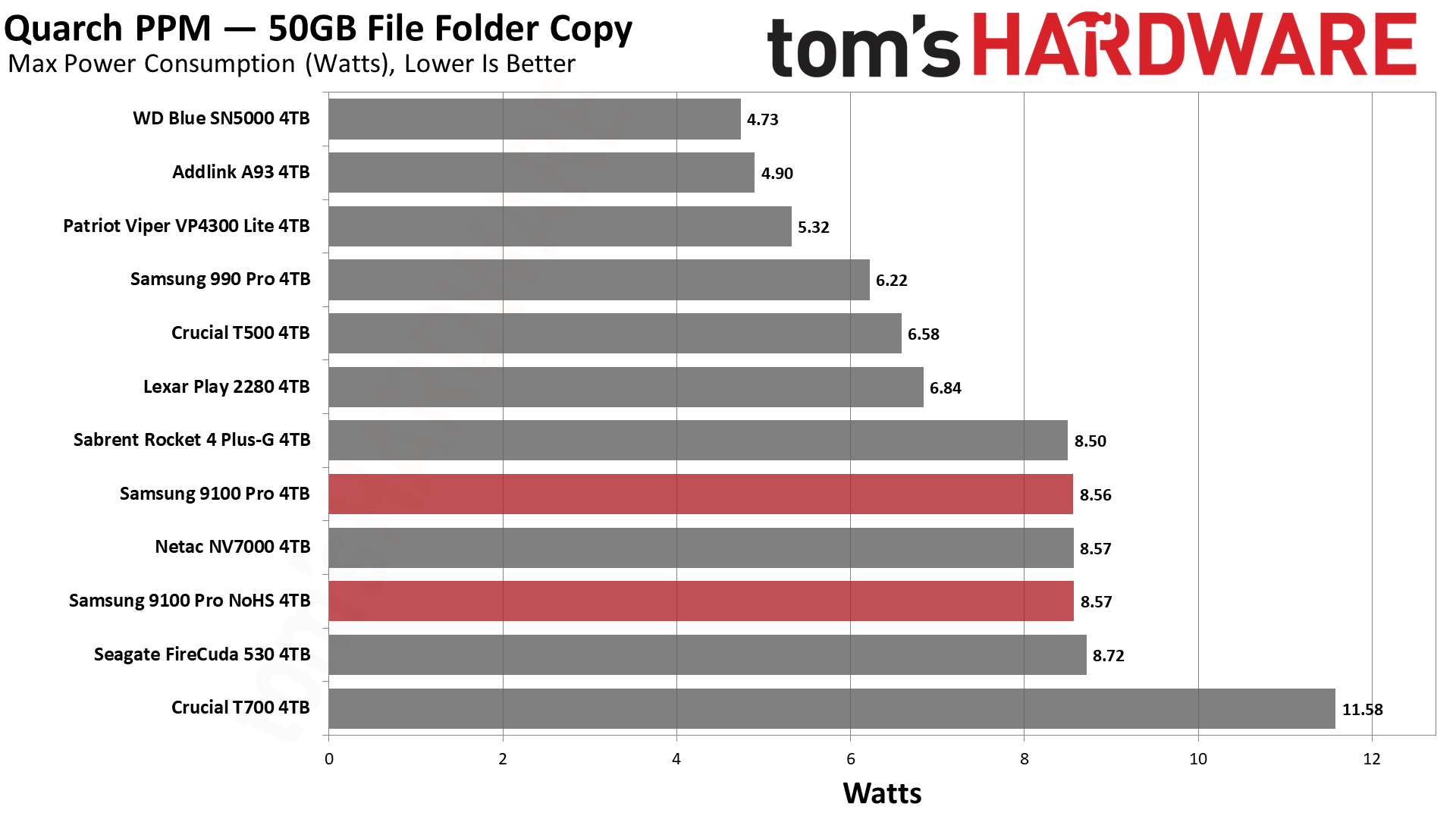
Having more flash does often mean higher power draw, and in the case of the 9100 Pro we’re looking at 8.7W to 9.3W for the peak SMART power states between 2TB and 4TB. However, the larger drive has a larger cache and more flash to work with so it can end up being more efficient in real-world workloads. This is the case here, and the 4TB 9100 Pro’s power consumption results are quite good. It’s certainly a lot better than the first high-end PCIe 5.0 SSDs, like the T700 and T705, that are built on Phison’s E26 controller.
We tested the 4TB 9100 Pro both with and without a heatsink, the latter state being the point of comparison with the 2TB. Without a heatsink the 4TB drive reached 71°C or 4°C more than the 2TB with a corresponding higher average temperature. This is to be expected when using more flash in an otherwise similar configuration. These temperatures are not bad, but Samsung’s heatsink helps a lot. With that applied we measured a maximum of 47°C, which is astoundingly cool. This drive will never have any problems when run with a heatsink of any sort, and in many cases it could be run bare without a problem. This is in contrast to the E26-based drives, which all effectively require a heatsink.
9100 Pro Bottom Line
The 9100 Pro is a fun drive to review because it has very clear advantages and disadvantages rather than being a lopsided victor or loser. This helps flesh out the storage market segment the drive fulfills, in this case for high-end PCIe 5.0, by drawing visible lines. For example, Phison-based early adopter drives were infamous for having high power draw even when idle and requiring a heatsink to prevent throttling or shutdown. The 9100 Pro has neither of those issues, but in a fair fight against upcoming hardware — see our Micron 4600 review — it’s not quite as impressive. Mid-range Phison-based drives, like the Corsair MP700 Elite or the PNY CS2150, also show the way SSDs are going with better performance and lower power draw.
Those are “budget” drives, though, as they have only four channels with no external DRAM caching. The 9100 Pro has more horsepower with eight channels and full DRAM, even though it’s not using new flash. It can also field a single-sided drive up to 4TB, a capacity which is still a work in progress for drives like the efficient WD Black SN7100, with an 8TB 9100 Pro SKU expected later this year. That capacity should be highly anticipated, but pricing will be a concern.
We want to emphasize that we do think the 4TB model is better than the 2TB model for this class of drive, especially as 1TB and 2TB seem fairly paltry by today’s standards, especially when considering the transfer speeds possible. The MSRP per gigabyte is best on the 4TB SKU, reinforcing our thinking. Samsung also uses tested and true hardware with robust support, which is distinct from the OEM warranty and nature of the 4600. That puts the 9100 Pro into a class of its own, but the absence of immediate and overwhelming competition does not mean it deserves a perfect score.
The fact is, the drive’s decent all-around performance and the lack of any striking weak point only makes it a good drive rather than a legendary one. Samsung was late to the party, and the 9100 Pro arrived right when we saw what alternative hardware could do. The drive is quite capable and will be a great option as it covers all bases — such as potentially being usable in laptops — but it delivers nothing earth-shattering to the market. It’s a very capable SSD from a solid brand that can check all the right boxes but doesn’t stand out enough to feel like a new level of drive. It’s more iterative than revolutionary, and that’s okay. Having the option of a reliable, high-end PCIe 5.0 SSD with a full capacity range is actually quite nice.
That said, this type of drive still only appeals to a relatively niche base of users. There are better options for those on a budget, better choices for power efficiency and laptop use, and a wide range of solid choices for the PS5, etc. The 9100 Pro does not really lead in any performance metric, so isn’t a must-have for any specific workload. It’s more of an all-encompassing Uber drive that you drop into an expensive, brand-new build without having to worry about the drawbacks of early-adopter technology. That’s a perfect place for Samsung to be, but it also means that you can keep on waiting if you want something more nuanced. It’s a great response from Samsung but simply doesn’t bring a death blow to the competition unless you’ve already been holding out for a Samsung brand drive.
MORE: Best SSDs
MORE: Best External SSDs
MORE: Best SSD for the Steam Deck

Shane Downing is a Freelance Reviewer for Tom’s Hardware US, covering consumer storage hardware.
-
VizzieTheViz Nice drives, but not particularly impressive.Reply
Why do you keep doing PlayStation testing with these drives? It’s in there every time and there’s literally hardly any difference between any of the reasonably fast drives, let alone a difference that a person might notice in daily use. Basically everything is just fast enough to max out the PlayStation storage. -
cyrusfox Sheesh those prices... for such a small increment in % improvement, I really don't expect these to sell well till the prices come down. $200 for 1tb, ~20cents/GB and $300 for 2tb ~15cents/GB, and 4TB for ~13.75cents/GB. All too spendy for this very cost sensitive segment. I like my cheap Gen 3 m2 drives though.Reply
Looking forward to future does a faster ssd matter segments comparing the latest drives all the way back to sata ssd and optane(still miss it) in the future. -
cyrusfox Reply
I honestly think that is the main market for overpriced m2 drives, the console market. So the testing is extremely relevant.VizzieTheViz said:Nice drives, but not particularly impressive.
Why do you keep doing PlayStation testing with these drives? It’s in there every time and there’s literally hardly any difference between any of the reasonably fast drives, let alone a difference that a person might notice in daily use. Basically everything is just fast enough to max out the PlayStation storage. -
VizzieTheViz Reply
Wel that’s sort of a reason I guess, getting console players to look at your review even, but as basically everything that’s been released the last year or two maxes out PlayStation storage it seems like a huge waste of time to me.cyrusfox said:I honestly think that is the main market for overpriced m2 drives, the console market. So the testing is extremely relevant. -
abufrejoval What irks me is that with 8TB becoming more or less normal with linear prices, you'd want to consolidate the drives you have.Reply
With SATA I'd put SSDs into a nice big JBOD in a 6x or 8x drive cage filling a 5 1/4" HH slot in the chassis and enjoy the lesser capacities a while longer in a crowd. A port multiplier or SAS expander was always lying around somewhere, too, affordable otherwise.
But with NVMe the real issue is scarcity of PCIe lanes (apart from having to dig in deep to get at them NVMe sticks), so what do you do with those nice 1TB sticks, that still show 99-97% remaining endurance?
PCIe switch chips seem to cost more than a 8TB drive, after Avago/Broadcom bought the PLX and others, the only affordable option I've seen is a PCIe v3 variant which allocates a single lane to each of of four M.2 slots it connects to a PCIe x4, so it's not much of a switch.
I'd really like to see something that's capable of aggregating say multiple PCIe v3 NMe drives into one PCIe v5 x4 or M.2 connector, and I believe PCIe would allow for that, but since I've never seen such a chip or card, there is a good chance I'm wrong. -
Digital~Dreams Why is this being compared to the Seagate firecuda 530 when there is a Seagate 540 4tb available ???Reply -
The5thCacophony My computer is old. It has only PCIe v3. I have no need of performance. Just a 2TB drive which should be reliable and silent. Storing photos and my old medias from CD and DVD.Reply
If there are Nvme drives compatible PCIe v5 or v4 at comparable cost as an old Nvme PCIe3, is it ok I buy the newer version?
